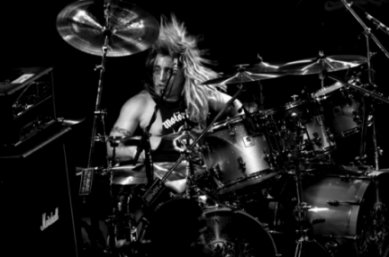Concert Review: Anvil
(San Francisco, CA, The Fillmore, 06-02-10)
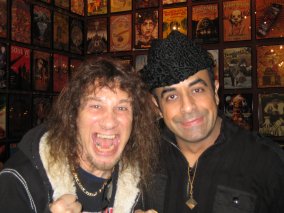 Anvil reminds me of Levi’s jeans and Twinkies, brands that have weathered a sea of trends. Regardless of current music and clothing trends, Steve “Lips” Kudlow (“SK”) plays and wears what he desires with a carefree dismissal of whether he is hip or fashionable. Any doubt about SK’s disinterest in musical trends is laid to rest by comparing Anvil’s first two records, Hard ‘N’ Heavy (1981) and Metal on Metal (1982), with Anvil’s latest record, This is Thirteen (2007). These records sound similar. Any doubt about SK’s carefree attitude about clothing trends is laid to rest by his appearance. SK continues to wear the metal head regalia that came to prominence in the early 1980’s, sneakers, snug-fitting black jean pants, rock t-shirt, and denim jacket with optional sheepskin interior lining.
Anvil reminds me of Levi’s jeans and Twinkies, brands that have weathered a sea of trends. Regardless of current music and clothing trends, Steve “Lips” Kudlow (“SK”) plays and wears what he desires with a carefree dismissal of whether he is hip or fashionable. Any doubt about SK’s disinterest in musical trends is laid to rest by comparing Anvil’s first two records, Hard ‘N’ Heavy (1981) and Metal on Metal (1982), with Anvil’s latest record, This is Thirteen (2007). These records sound similar. Any doubt about SK’s carefree attitude about clothing trends is laid to rest by his appearance. SK continues to wear the metal head regalia that came to prominence in the early 1980’s, sneakers, snug-fitting black jean pants, rock t-shirt, and denim jacket with optional sheepskin interior lining.
On Saturday, February 6, 2010, Anvil played The Fillmore in San Francisco. Anvil played 13 songs during an 83-minute set from 9:22 to 10:45. The festivities, or more appropriately, metalities, are discussed in greater detail below.
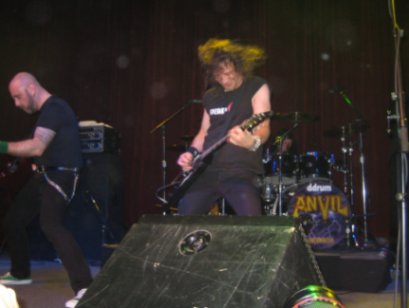
1. March of the Crabs (Metal on Metal record, 1982) was the first of four songs Anvil performed off Metal on Metal, an instrumental that clocks in at over 2:30 seconds. I admire Anvil for having the confidence to play an instrumental as the opening song. Most bands would not venture to perform an instrumental song, particularly as the set opener, because it leaves them “exposed and naked.” [Neither alarms SK. After all, SK displays his family jewels in “Anvil! The Story of Anvil” documentary (2009).] The lack of vocals that otherwise adds a layer to the musical canvas means musicians have to be confident in their musicianship to rely solely on their instrument-playing skills. SK masterfully ran off a battery of riffs on his battle-scarred, black flying V guitar, one of two that has comprised his arsenal for at least 21 years, while Glenn Gyorffy (aka Glenn Five/G5) (“G5”) played a maroon five-string Gibson Thunderbird bass.
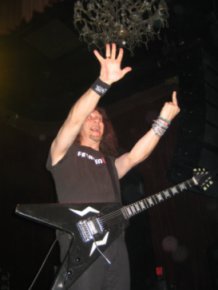 2. 666 (Metal on Metal, 1982) is a powerful, fast-paced song clearly demonstrating the band’s thrash roots and why Metallica, Slayer, and Anthrax cite Anvil as an influence. At the conclusion of the song SK displayed the sign language version of the song title, his open right hand displaying five digits and his left hand displaying, what else, the middle finger.
2. 666 (Metal on Metal, 1982) is a powerful, fast-paced song clearly demonstrating the band’s thrash roots and why Metallica, Slayer, and Anthrax cite Anvil as an influence. At the conclusion of the song SK displayed the sign language version of the song title, his open right hand displaying five digits and his left hand displaying, what else, the middle finger.
3. School Love (Hard ‘N’ Heavy, 1981). Before School Love SK said, “We are so lucky to play at this venue.” SK wore a black muscle shirt with the phrase, “freaken eh” printed in white and red lettering on his chest, black jean pants, studded belt, white sneakers, and a black sweatband on his right arm. Anvil launched into School Love, a song with a catchy chorus and verse. This is a fairly light rock song, Anvil’s lightest in an otherwise heavy set.
4. Winged Assassins (Forged in Fire, 1983). SK introduced the next song as “an anti-war song.” Robb Reiner (“RR”) started the punishing song by subjecting his floor toms to some heavy-handed beating. RR wore a black snap button leather vest, long-sleeve black cotton shirt, black jeans, and a black bandana atop his head. RR played a black-colored ddrum drum set with double bass drums featuring the Anvil logo and lightning bolts in each bass drum head along with the word “Robb” in one drum head and “Reiner” in the other. Winged Assassins has an Iron Maidenesque quality to it. After SK’s solo, RR and G5 provided rollicking drum beats and bass lines, with G5 spreading his legs and using his fingers to nimbly pluck his bass strings without a pick a la Steve Harris (Iron Maiden bassist). [G5 looked as if he was stretching for a heavy duty sumo wrestling session. I anticipated seeing G5 take his pants off to reveal a white mawashi (i.e., cloth worn to cover the private area), clap his hands, stomp his feet, and throw salt over his shoulders.
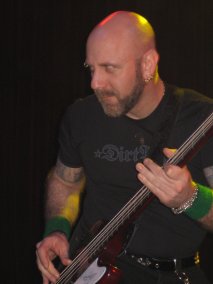 5. This Is Thirteen (This is Thirteen, 2007). Before This Is Thirteen SK said, “I do not fit your typical rocker stereotype. I am a music fan. It sucks when musicians do not come out and meet their fans. After the show I want to meet everyone. You have been to my house. You know my mother” [referring to scenes from “Anvil! The Story of Anvil” documentary]. I felt bad for the fans who paid the additional money above and beyond the $17 face value ticket price for a pre-show chance to meet the band, including obtaining a copy of This is Thirteen, “Anvil! The Story of Anvil” DVD and Anvil fanny pack. However, judging from SK’s graciousness and friendliness when I met him, he likely would have reached in his pants pocket and refunded the money requested by any disgruntled fan. [Given RR’s onscreen penchant to casually smoke marijuana as if sucking on tic tacs, it is safer for SK to perform this task because RR may inadvertently pull out a roach in lieu of currency, and not of the insect variety.]
5. This Is Thirteen (This is Thirteen, 2007). Before This Is Thirteen SK said, “I do not fit your typical rocker stereotype. I am a music fan. It sucks when musicians do not come out and meet their fans. After the show I want to meet everyone. You have been to my house. You know my mother” [referring to scenes from “Anvil! The Story of Anvil” documentary]. I felt bad for the fans who paid the additional money above and beyond the $17 face value ticket price for a pre-show chance to meet the band, including obtaining a copy of This is Thirteen, “Anvil! The Story of Anvil” DVD and Anvil fanny pack. However, judging from SK’s graciousness and friendliness when I met him, he likely would have reached in his pants pocket and refunded the money requested by any disgruntled fan. [Given RR’s onscreen penchant to casually smoke marijuana as if sucking on tic tacs, it is safer for SK to perform this task because RR may inadvertently pull out a roach in lieu of currency, and not of the insect variety.]
Anvil performed This is Thirteen, the first of three songs off This is Thirteen, a song with an eerie vibe featuring a straightforward introductory drum beat by RR and a plodding chord progression by SK reminiscent of Black Sabbath. This is a powerful song with an evil tinge. [The song is so dark and brooding I thought SK would come out on stage dressed in a hooded cloak worn by the grim reaper or The Emperor from George Lucas’s science fiction film, “The Return of the Jedi” (1983), light a candelabra, and summon spirits using a ouija board.] During SK’s guitar solo, G5 went back to RR’s drum set and placed his foot on the one-foot high black-colored drum riser. G5 wore a black t-shirt with the phrase, “Dirt Bag” printed in grey letters on his chest, black jean pants (with two chains extending from his belt loop to his back pocket), studded belt, green Converse sneakers, and green sweatbands.
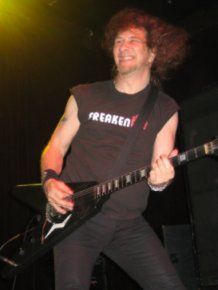 6. Mothra (Metal on Metal, 1982) is an up tempo song with a chugging riff. SK’s voice struggled during the first verse, but was then in fine form. SK effortlessly played a guitar solo. [SK played with such fluidity he would have been able to crochet while wailing on his flying V.] G5 periodically used his right fist to slam on the body of his bass. Following SK’s guitar solo, SK played power chords galore. RR played three drum beats on his floor toms after which SK and G5 stopped playing. SK lifted his guitar to his mouth and repeatedly shouted “yeah” into the guitar pickups, using them as a makeshift microphone. Interestingly, SK’s voice reverberated through his guitar amplifiers in a muffled tone prompting the audience to shout “yeah” back. SK pulled out his weapon of choice, a silver dildo from his right rear pants pocket. With a sly grin from ear to ear, SK held his trademark weapon in the air, basking in the moment as the dildo shimmered in the spotlight. [SK held the dildo with such pride and poise he looked like the final runner in the Olympic torch relay given the noble task of running to the cauldron placed atop a grand staircase and using the torch, in this case a dildo, to signify the commencement of the Olympic Games.] SK sat on a stage monitor stage front,
6. Mothra (Metal on Metal, 1982) is an up tempo song with a chugging riff. SK’s voice struggled during the first verse, but was then in fine form. SK effortlessly played a guitar solo. [SK played with such fluidity he would have been able to crochet while wailing on his flying V.] G5 periodically used his right fist to slam on the body of his bass. Following SK’s guitar solo, SK played power chords galore. RR played three drum beats on his floor toms after which SK and G5 stopped playing. SK lifted his guitar to his mouth and repeatedly shouted “yeah” into the guitar pickups, using them as a makeshift microphone. Interestingly, SK’s voice reverberated through his guitar amplifiers in a muffled tone prompting the audience to shout “yeah” back. SK pulled out his weapon of choice, a silver dildo from his right rear pants pocket. With a sly grin from ear to ear, SK held his trademark weapon in the air, basking in the moment as the dildo shimmered in the spotlight. [SK held the dildo with such pride and poise he looked like the final runner in the Olympic torch relay given the noble task of running to the cauldron placed atop a grand staircase and using the torch, in this case a dildo, to signify the commencement of the Olympic Games.] SK sat on a stage monitor stage front, 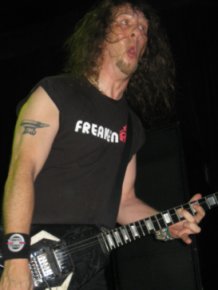 gripped the dildo with might in his left hand, much as he has done for at least 26 years, and ran it up and down his guitar neck, substituting the dildo for a guitar slide. SK switched the dildo to his right hand, demonstrating his dexterity as he tapped the dildo on his guitar strings while strumming chords with his left hand. Some of the audience members had a mesmerized look on their face, akin to the look on the faces of those who witnessed Jimi Hendrix light his Fender Stratocaster guitar on fire at London’s Astoria club (03-31-67) and the Monterey International Pop Festival (06-18-67). True, SK’s antics are not as earth shattering as Hendrix’s, but how many guitarists are able to captivate an audience by playing a guitar with a fake penis?!SK got up from the stage monitor and returned his weapon (i.e., dildo) to its holster (i.e., rear pants pocket). SK played a two-minute guitar solo that included a chugging chord progression he played progressively slower. I would have omitted this latter solo as the highlight was the solo with the dildo. The subsequent solo caused the song to drag a bit and took away the momentum created by witnessing SK a man play a guitar with a prosthetic penis. At the end of the song SK went back to the four guitar amplifiers located at the rear of stage left for guitar feedback a la Ritchie Blackmore (former Deep Purple and Rainbow guitarist).
gripped the dildo with might in his left hand, much as he has done for at least 26 years, and ran it up and down his guitar neck, substituting the dildo for a guitar slide. SK switched the dildo to his right hand, demonstrating his dexterity as he tapped the dildo on his guitar strings while strumming chords with his left hand. Some of the audience members had a mesmerized look on their face, akin to the look on the faces of those who witnessed Jimi Hendrix light his Fender Stratocaster guitar on fire at London’s Astoria club (03-31-67) and the Monterey International Pop Festival (06-18-67). True, SK’s antics are not as earth shattering as Hendrix’s, but how many guitarists are able to captivate an audience by playing a guitar with a fake penis?!SK got up from the stage monitor and returned his weapon (i.e., dildo) to its holster (i.e., rear pants pocket). SK played a two-minute guitar solo that included a chugging chord progression he played progressively slower. I would have omitted this latter solo as the highlight was the solo with the dildo. The subsequent solo caused the song to drag a bit and took away the momentum created by witnessing SK a man play a guitar with a prosthetic penis. At the end of the song SK went back to the four guitar amplifiers located at the rear of stage left for guitar feedback a la Ritchie Blackmore (former Deep Purple and Rainbow guitarist).
7. Flying Blind (This is Thirteen, 2007). Before Flying Blind SK said, “I am glad to be alive guys!” [The joy and enthusiasm contained in the intonation in SK’s voice and expression on his face were patently clear. SK’s sincerity was as obvious as the stench of manure at a rodeo and beer at a fraternity keg party.] SK asked, “Have any of you ever been on a blind date? I got blisters!” SK’s jovial nature demonstrated his sense of humor and ability to connect with the audience on a personal level. This natural ability is partially responsible for Anvil’s newfound success and ability to maintain a devoted fan base since 1978. Admittedly, Paul Stanley (Kiss lead vocalist and rhythm guitarist) used a similar catch line when asked by a journalist to describe his firs sexual experience during the Australian leg of Kiss’s Unmasked tour (1980). Paul quipped, “I got hand blisters.” Regardless, like a classic Rodney Dangerfield joke, SK’s joke was still effective. The band performed Flying Blind, an up tempo song with a country tinge and “shuffle” feel. G5 impressively played a black 12-string bass, his picking fingers nimbly moving across the strings with great speed akin to Tom Araya (Slayer bassist) flailing away the frenetic bass lines to Slayer’s Hell Awaits from the Hell Awaits record (1985). It was impressive to see a metal band pull off such a song, but it did not quite fit in with the rest of the set. [I expected to see Garth Brooks stomp on stage with his 10-gallon cowboy hat and begin line dancing with SK and G5.]
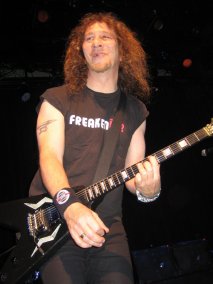 8. Thumb Hang (This is Thirteen, 2009 (re-release)). Before Thumb Hang, SK caught a black bra in mid air and mounted it on his microphone stand as if proudly displaying his trophy. [Given the gargantuan size of the bra I was surprised the stand did not sway like the Leaning Tower of Pisa.] After regaining his arm strength from mounting his enormous prize, SK paid homage to one of his heroes, Ronnie James Dio (Black Sabbath and Dio vocalist). “Ever since I was a kid I listened to Black Sabbath. Forty years later I am still a kid and still listen to Black Sabbath. I got to know the guys in Black Sabbath because Anvil opened for them. Ronnie James Dio is home undergoing chemotherapy. He is beating the [stomach] cancer.” The audience enthusiastically clapped. SK introduced Thumb Hang as a song “inspired by the boys” (i.e., Black Sabbath). Thumb Hang begins as a slow tempo song with plenty of “aah” “aahs,” and, approximately 90 seconds into the song, shifts to a fast tempo followed by a fiery SK guitar solo on his flying V accompanied by G5 on his maroon Gibson Thunderbird bass. After SK’s solo, the tempo resumed a slow pace. Anvil was wise to add this strong rocker as a bonus track to the version of This is Thirteen re-released by VH1 Records in 2009.
8. Thumb Hang (This is Thirteen, 2009 (re-release)). Before Thumb Hang, SK caught a black bra in mid air and mounted it on his microphone stand as if proudly displaying his trophy. [Given the gargantuan size of the bra I was surprised the stand did not sway like the Leaning Tower of Pisa.] After regaining his arm strength from mounting his enormous prize, SK paid homage to one of his heroes, Ronnie James Dio (Black Sabbath and Dio vocalist). “Ever since I was a kid I listened to Black Sabbath. Forty years later I am still a kid and still listen to Black Sabbath. I got to know the guys in Black Sabbath because Anvil opened for them. Ronnie James Dio is home undergoing chemotherapy. He is beating the [stomach] cancer.” The audience enthusiastically clapped. SK introduced Thumb Hang as a song “inspired by the boys” (i.e., Black Sabbath). Thumb Hang begins as a slow tempo song with plenty of “aah” “aahs,” and, approximately 90 seconds into the song, shifts to a fast tempo followed by a fiery SK guitar solo on his flying V accompanied by G5 on his maroon Gibson Thunderbird bass. After SK’s solo, the tempo resumed a slow pace. Anvil was wise to add this strong rocker as a bonus track to the version of This is Thirteen re-released by VH1 Records in 2009.
9. White Rhino (Still Going Strong, 2002). Before White Rhino, SK said, “It is time to recharge.” SK unplugged the guitar cord from his guitar so he could switch to his other axe. Before plugging the cord into his second guitar, SK inserted the cord into his mouth, much like a sword swallower. When the metal end of the chord struck SK’s tongue it created crackling and feedback in his amplifiers. SK jokingly pointed to his mouth and said, “This is my new guitar! [In such a case, SK could add “Loudmouth” as another nickname.] I have been friends with Robb since 1973. Nothing makes him happier and to smile than to hear the crowd.” The audience roared as the spotlight shined on RR. RR stood up behind his massive drum set, displaying a beaming smile, something that, by RR’s own admission, he does not often do.
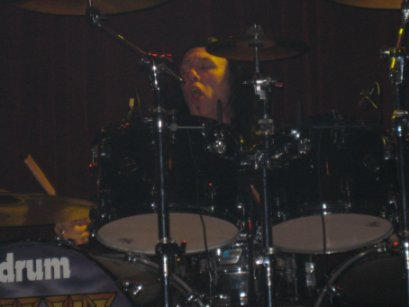
Anvil performed White Rhino, the second instrumental of the set and the only song from the 1988 to 2006 time period. My admiration for Anvil grew further. Most bands would not dare perform one instrumental song, much less two. Anvil could care less about convention. [SK would rather raise his middle finger right before launching into whatever song his heart desired, be it an instrumental, a polka tune, or a waltz where he decides to embrace RR and gracefully dance across the stage in a flowing sequin dress.]
White Rhino is an up tempo song with a thrash feel. RR delivered a solid drum beat with drum fills for flavor. G5 pounded away on his bass’s body. SK got on his knees and burned on his flying V. White Rhino included a two-minute RR drum solo during which G5 left the stage. However, SK maintained a nondescript presence in the rear of the stage by his amplifiers tuning his guitar. After he was done tuning, SK walked within a few feet of RR’s drum riser and intently watched and listened to RR’s impressive solo with admiration and glee, refusing to take his eyes of his metal brethren since high school. When RR struck the last beats on his snare drum and floor tom, SK clenched his fist signaling that RR had “nailed it.” SK exclaimed, “How amazing is that! Robb Reiner rocks man! No. San Francisco rocks man!”
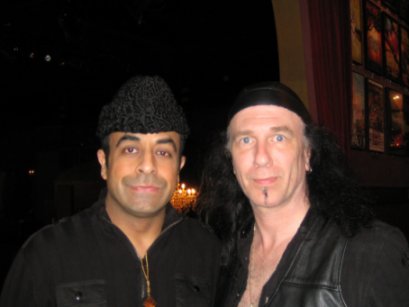
10. Mad Dog (Strength of Steel, 1987). Before Mad Dog, a song for which Anvil recorded a music video that received a fair amount of air play on MTV’s “Headbangers Ball,” SK said, “I used to own a bulldog named Beast. Beast liked strangers. He would mount them and ride!” SK told a brief story about how he sold Beast to an unsuspecting girl in a pet store. “I wrote a song about my bulldog. It is called Mad Dog.” Mad Dog is an up tempo song with a catchy chorus and chugging riff. At the end of the song SK shouted, “San Francisco, I am just a mad mad dog!”
11. Forged in Fire (Forged in Fire, 1983) features a wicked riff and ominous guitar trill (i.e., rapid alternation of two adjacent tones). G5 played his 12-string bass. During the mid-section of the song G5 and SK approached each other center stage, stood within a few feet of each other and jammed. Forged in Fire, along with This Is Thirteen, were undeniably the heaviest songs Anvil performed. These songs celebrate what is metal in its purest form, loud power chords and drum beats that hit the listener in the gut with such force he is left breathless.
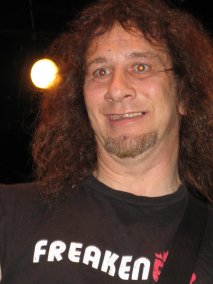 12. Metal on Metal (Metal on Metal, 1982). SK introduced Metal on Metal as the “last song for you.” Metal on Metal is prominently featured in “Anvil! The Story of Anvil” documentary and features a catchy chord progression. Following SK’s solo, SK and G5 raised their hands above their heads and clapped, encouraging the audience to follow suit. As the stage lights shined into the crowd, I looked back at the audience from front row and was pleased to see the 1,200-seat theater approximately 75 percent full, a much healthier turn out than the handful of fans in attendance at Anvil’s Munich, Germany show captured on “Anvil! The Story of Anvil.” At the end of the song SK said, “San Francisco, I had a magnificent night. Thank you and god bless.” The band left the stage at 10:40 and returned in one minute to play one additional song.
12. Metal on Metal (Metal on Metal, 1982). SK introduced Metal on Metal as the “last song for you.” Metal on Metal is prominently featured in “Anvil! The Story of Anvil” documentary and features a catchy chord progression. Following SK’s solo, SK and G5 raised their hands above their heads and clapped, encouraging the audience to follow suit. As the stage lights shined into the crowd, I looked back at the audience from front row and was pleased to see the 1,200-seat theater approximately 75 percent full, a much healthier turn out than the handful of fans in attendance at Anvil’s Munich, Germany show captured on “Anvil! The Story of Anvil.” At the end of the song SK said, “San Francisco, I had a magnificent night. Thank you and god bless.” The band left the stage at 10:40 and returned in one minute to play one additional song.
13. Jackhammer (Backwaxed, 1985). SK resumed his entertaining storytelling ritual. “I used to share a hotel room with our [former] bass player. He was a ladies man. One night he brought a sleazy lady to the hotel room. I woke up and she asked if she could do me! Her name was Jonah but I called her Jackhammer.” Jackhammer, along with 666, were the fastest songs of the night featuring a frenetic guitar chord progression and guitar solo. SK sang the verses and chorus in rapid (i.e., “jackhammer”) fashion. Jackhammer was an excellent choice to close the set.
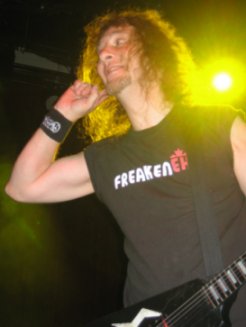 At 10:45 the band took a bow ending the metal onslaught. SK came up to the microphone for one last time and said, “Give me five to 10 minutes to towel off, and I will come out and meet each and every one of you who hangs out.” Two flashback memories are worthy of mention. First, I recall seeing guitar maestro Yngwie Malmsteen perform at The Independent (“TI”) club in San Francisco on November 9, 2005. In contrast to SK’s minimal stage gear comprised of four mid-size guitar amplifiers for a 1,200-seat theater, Yngwie elected to place 14, yes 14, 100-watt Marshall amplifiers and Marshall heads on the tiny stage of the 375-seat club. After I reached front row at TI and observed the mountain of Marshalls within 20 feet of me, I began to salivate at the impending audio onslaught. I knew one strum of a power chord by Yngwie on his Fender Stratocaster would reduce my teeth to fine enamel dust. Upon closer inspection I realized Yngwie only had one of the 14 Marshall amplifiers and heads turned on. In contrast, SK did not feel a need for visual deception. Four road weary, mid-size guitar amplifiers sufficed for a venue three times as large as TI.
At 10:45 the band took a bow ending the metal onslaught. SK came up to the microphone for one last time and said, “Give me five to 10 minutes to towel off, and I will come out and meet each and every one of you who hangs out.” Two flashback memories are worthy of mention. First, I recall seeing guitar maestro Yngwie Malmsteen perform at The Independent (“TI”) club in San Francisco on November 9, 2005. In contrast to SK’s minimal stage gear comprised of four mid-size guitar amplifiers for a 1,200-seat theater, Yngwie elected to place 14, yes 14, 100-watt Marshall amplifiers and Marshall heads on the tiny stage of the 375-seat club. After I reached front row at TI and observed the mountain of Marshalls within 20 feet of me, I began to salivate at the impending audio onslaught. I knew one strum of a power chord by Yngwie on his Fender Stratocaster would reduce my teeth to fine enamel dust. Upon closer inspection I realized Yngwie only had one of the 14 Marshall amplifiers and heads turned on. In contrast, SK did not feel a need for visual deception. Four road weary, mid-size guitar amplifiers sufficed for a venue three times as large as TI.
Second, the bewildered look on SK’s face when we met and he first took a gander at my karakul hat (i.e., hat made from sheep fur) and cherry red Dr. Martens combat boots reminded me of the look on the faces of airport security officials. SK certainly had no ill intentions because he demonstrated bewilderment, not suspicion. Regardless, SK’s prolonged stare brought back fond memories of the “special treatment” I receive at 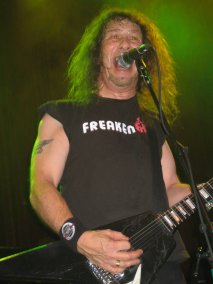 airports, dating back to the 1980’s, long before the heightened security implemented after the unfortunate September 11th terrorist attacks. The special treatment is a fun way for me to keep myself amused during boring trips to the airport. I recall one occasion in July 1991 where I gave my older brother and his then-wife a ride to the airport. The lovely newlyweds were in a relaxed state looking forward to a pleasant Florida honeymoon. My brother stood at the airline ticket counter. I stood approximately 10 feet behind my brother. In my periphery I noticed a security guard donning a plastic badge staring at me. I got bored and decided to entertain myself at the security guard’s expense. I started flashing glances at the guard with an insane look in my eyes, similar to the one Jack Nicholson flashed as he chopped through the bathroom door in Stanley Kubrick’s psychological horror film, “The Shining” (1980). After the third gaze, I noticed the guard getting uneasy, whispering something to his colleagues via his walkie talkie shoulder speaker. The guard walked toward me, prompting me to non-chalantly walk up next my brother positioned between the guard and me. The guard sternly said to my brother, “Where are you traveling to? Let me see your passport.” My brother, who has a thinner skin for differential treatment and was oblivious to the mental stamina test I subjected the guard to, became infuriated and shouted, “I am only going to Florida! Why would I be carrying my passport! What do you want with my passport!” [My brother’s complexion morphed so quickly I thought he was a chameleon trying to blend with a bed of deep red roses.] The guard, who was now joined by two of his colleagues, thereby comprising The Three Stooges, passively nodded, ignoring my brother’s tirade, and repeated, “Just let me see your passport.” I gently tugged on my brother’s shirt and, with a feeble attempt to control my laughter, whispered the pre-interrogation events to him. My brother rolled his eyes and, with a stern frown and beads of perspiration on his glistening forehead stated, “Can’t you ever behave?!”
airports, dating back to the 1980’s, long before the heightened security implemented after the unfortunate September 11th terrorist attacks. The special treatment is a fun way for me to keep myself amused during boring trips to the airport. I recall one occasion in July 1991 where I gave my older brother and his then-wife a ride to the airport. The lovely newlyweds were in a relaxed state looking forward to a pleasant Florida honeymoon. My brother stood at the airline ticket counter. I stood approximately 10 feet behind my brother. In my periphery I noticed a security guard donning a plastic badge staring at me. I got bored and decided to entertain myself at the security guard’s expense. I started flashing glances at the guard with an insane look in my eyes, similar to the one Jack Nicholson flashed as he chopped through the bathroom door in Stanley Kubrick’s psychological horror film, “The Shining” (1980). After the third gaze, I noticed the guard getting uneasy, whispering something to his colleagues via his walkie talkie shoulder speaker. The guard walked toward me, prompting me to non-chalantly walk up next my brother positioned between the guard and me. The guard sternly said to my brother, “Where are you traveling to? Let me see your passport.” My brother, who has a thinner skin for differential treatment and was oblivious to the mental stamina test I subjected the guard to, became infuriated and shouted, “I am only going to Florida! Why would I be carrying my passport! What do you want with my passport!” [My brother’s complexion morphed so quickly I thought he was a chameleon trying to blend with a bed of deep red roses.] The guard, who was now joined by two of his colleagues, thereby comprising The Three Stooges, passively nodded, ignoring my brother’s tirade, and repeated, “Just let me see your passport.” I gently tugged on my brother’s shirt and, with a feeble attempt to control my laughter, whispered the pre-interrogation events to him. My brother rolled his eyes and, with a stern frown and beads of perspiration on his glistening forehead stated, “Can’t you ever behave?!”
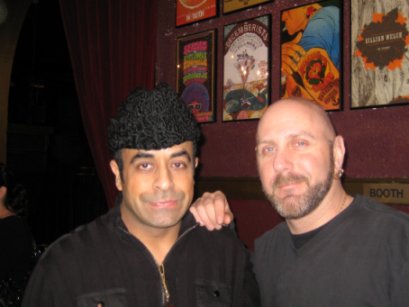
Venue: The Fillmore (“TF”) is a historic San Francisco theater that, in the mid-1960s, under the direction of legendary late Bay Area rock promoter Bill Graham, was the site of psychedelic and rock music and counterculture. TF’s early days featured acts such as Led Zeppelin, The Who, Pink Floyd, Cream, The Grateful Dead, Jefferson Airplane, Jimi Hendrix Experience, and The Doors. TF is a 1,200-seat capacity venue with a standing room floor similar to an oversized dance hall. Positioned above the floor are 10 chandeliers. The second floor contains a bar and box seats, specifically, six box seats stage right and another two, along with the mixing room, across the stage. Opening Band: Attitude Adjustment.
Arash Moussavian, Entertainment Law Attorney
arashmoussavian@cal.berkeley.edu
http://www.linkedin.com/in/arashmoussavian
All photos taken by Arash Moussavian. This article and all photos are protected by copyright. Please contact me prior to use, or I will make shish kabab of your loins.
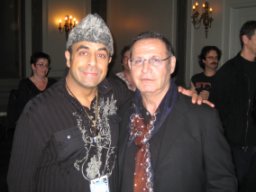 The hazing by my high school friends for attending a Styx concert was inevitable. One friend stated, “Boy, Arash, I’m sorry. I feel for you. That must have been a brutal, awful night.” It was shocking to my friends that I would see Styx because even as early as age 14 I literally developed whiplash from head banging and carpal tunnel from overuse of the devil horns at metal concerts, and I clenched and drooled on Exodus’s Bonded by Blood (1985) and Slayer’s Reign in Blood (1986) records like makeshift pacifiers being suckled by a mentally underdeveloped child. However, after accepting the invitation of Foreigner’s keyboardist, Michael Bluestein, and witnessing the great concert Foreigner put on in October 2009, I decided to become more open?minded about music, humbly accepting Lawrence Gowan’s (singer and keyboardist) invitation to see Styx. I am glad I did because before Styx reached the chorus of the first song, it was patently apparent to anyone in attendance, regardless of chromosome count, alcohol consumption level, or distraction by the presence of a nearby beautiful damsel, the band is a group of polished consummate professional musicians whose main objective is to deliver an entertaining show while having fun.
The hazing by my high school friends for attending a Styx concert was inevitable. One friend stated, “Boy, Arash, I’m sorry. I feel for you. That must have been a brutal, awful night.” It was shocking to my friends that I would see Styx because even as early as age 14 I literally developed whiplash from head banging and carpal tunnel from overuse of the devil horns at metal concerts, and I clenched and drooled on Exodus’s Bonded by Blood (1985) and Slayer’s Reign in Blood (1986) records like makeshift pacifiers being suckled by a mentally underdeveloped child. However, after accepting the invitation of Foreigner’s keyboardist, Michael Bluestein, and witnessing the great concert Foreigner put on in October 2009, I decided to become more open?minded about music, humbly accepting Lawrence Gowan’s (singer and keyboardist) invitation to see Styx. I am glad I did because before Styx reached the chorus of the first song, it was patently apparent to anyone in attendance, regardless of chromosome count, alcohol consumption level, or distraction by the presence of a nearby beautiful damsel, the band is a group of polished consummate professional musicians whose main objective is to deliver an entertaining show while having fun.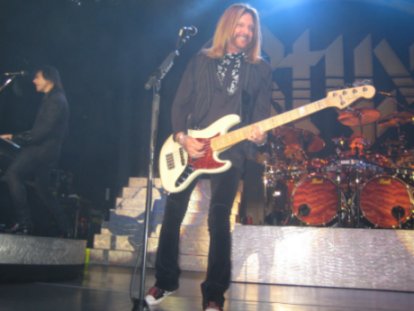
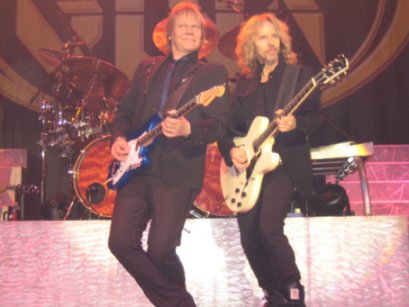
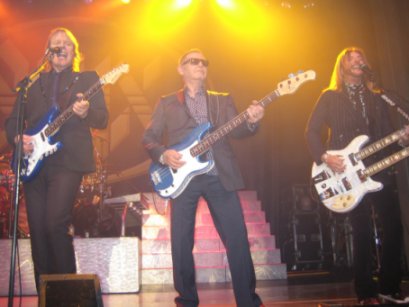
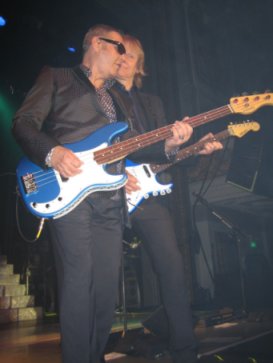 1. Fooling Yourself (The Angry Young Man) features a catchy chorus and a keyboard solo during which LG, who has a strong stage presence, rotated his single silver keyboard with a gold “Styx” logo 180 degrees and played part of the solo facing the crowd with his body stretched forward, and his hands nimbly hitting the ivory keyboard keys behind his back.
1. Fooling Yourself (The Angry Young Man) features a catchy chorus and a keyboard solo during which LG, who has a strong stage presence, rotated his single silver keyboard with a gold “Styx” logo 180 degrees and played part of the solo facing the crowd with his body stretched forward, and his hands nimbly hitting the ivory keyboard keys behind his back.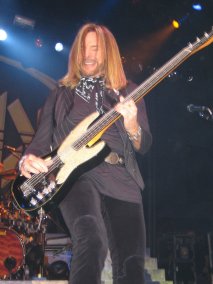 3. Too Much Time on My Hands (Paradise Theater, 1981). TSh handled lead vocals to this up tempo song with a catchy chorus. RP, who played a punchy bass line, was also finely dressed in a vertical?pin striped sleeveless wool blazer, long?sleeve black cotton shirt, black suede pants, black sneakers, and a black bandana with a white print around his neck. During the guitar solo, TSh, JY, and RP stood next to one another center stage and jammed.
3. Too Much Time on My Hands (Paradise Theater, 1981). TSh handled lead vocals to this up tempo song with a catchy chorus. RP, who played a punchy bass line, was also finely dressed in a vertical?pin striped sleeveless wool blazer, long?sleeve black cotton shirt, black suede pants, black sneakers, and a black bandana with a white print around his neck. During the guitar solo, TSh, JY, and RP stood next to one another center stage and jammed.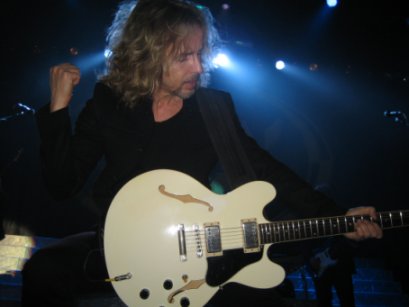
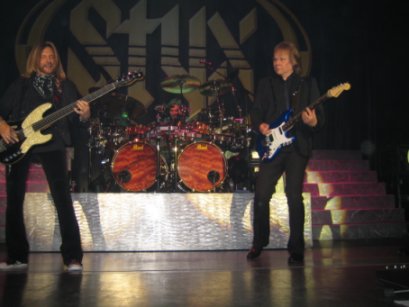
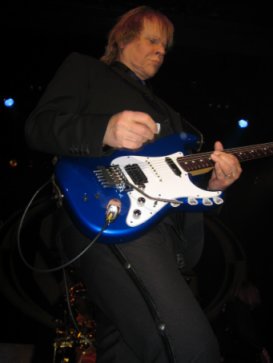 10. Suite Madame Blue (Equinox, 1975). Before the start of the next song JY asked the audience whether they “will help Lawrence Gowan sing.” LG sang lead vocals without a keyboard accompaniment while sitting atop his keyboard. LG was aided by TSh’s 12-string electric guitar, RP’s bass line, and TSu’s light cymbal notes. Suite Madame Blue has a soft tinge for the first 2:00 minutes after which it transforms into a mid tempo power ballad with LG walking around stage singing with emotion. At approximately the 3:30 song mark, LG returned to his keyboard riser and played an atmospheric slow tempo 45?second keyboard piece reminiscent of Pink Floyd and Yes. At approximately the 4:20 song mark, JY kicked the song into up tempo mode. LG jumped stage front, JY played a fiery guitar riff on his brown Fender Stratocaster with plenty of left?hand vibrato, while TSh, TSu, and RP jammed along.
10. Suite Madame Blue (Equinox, 1975). Before the start of the next song JY asked the audience whether they “will help Lawrence Gowan sing.” LG sang lead vocals without a keyboard accompaniment while sitting atop his keyboard. LG was aided by TSh’s 12-string electric guitar, RP’s bass line, and TSu’s light cymbal notes. Suite Madame Blue has a soft tinge for the first 2:00 minutes after which it transforms into a mid tempo power ballad with LG walking around stage singing with emotion. At approximately the 3:30 song mark, LG returned to his keyboard riser and played an atmospheric slow tempo 45?second keyboard piece reminiscent of Pink Floyd and Yes. At approximately the 4:20 song mark, JY kicked the song into up tempo mode. LG jumped stage front, JY played a fiery guitar riff on his brown Fender Stratocaster with plenty of left?hand vibrato, while TSh, TSu, and RP jammed along.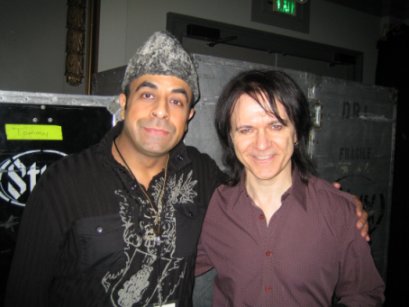
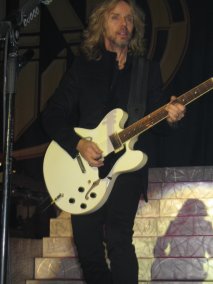 14. Ruby Tuesday (The Rolling Stones cover: Between the Buttons, 1967). Before the next song, TSh commented, “We all sound great.” TSh was correct. Like The Beatles and Kiss, Styx has the benefit of a band with multiple lead vocalists (e.g., The Beatles, Kiss), affording the band to write and perform a host of songs suited for varying vocal styles. TSh told a story about walking down Mason Street, a street in the theater district of downtown San Francisco. TSh asked, “Are my pants tight?” [In reality, TSh’s pants were not that tight. I was tempted to run up on stage next to TSh and turn around to reveal my behind to the shock of the audience, serving as a somber warning about the ill effects of too many cup cakes, and not of the female variety.] LG welcomed the audience to sing along and proudly took out a laminated lyric sheet for Ruby Tuesday. LG sang the first verse and chorus while sitting behind his keyboard. This song led straight into Come Sail Away.
14. Ruby Tuesday (The Rolling Stones cover: Between the Buttons, 1967). Before the next song, TSh commented, “We all sound great.” TSh was correct. Like The Beatles and Kiss, Styx has the benefit of a band with multiple lead vocalists (e.g., The Beatles, Kiss), affording the band to write and perform a host of songs suited for varying vocal styles. TSh told a story about walking down Mason Street, a street in the theater district of downtown San Francisco. TSh asked, “Are my pants tight?” [In reality, TSh’s pants were not that tight. I was tempted to run up on stage next to TSh and turn around to reveal my behind to the shock of the audience, serving as a somber warning about the ill effects of too many cup cakes, and not of the female variety.] LG welcomed the audience to sing along and proudly took out a laminated lyric sheet for Ruby Tuesday. LG sang the first verse and chorus while sitting behind his keyboard. This song led straight into Come Sail Away.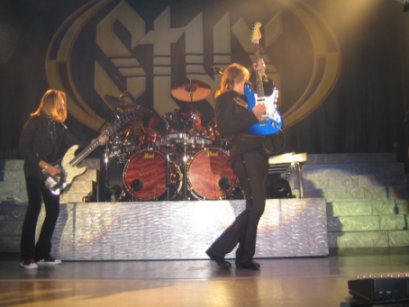
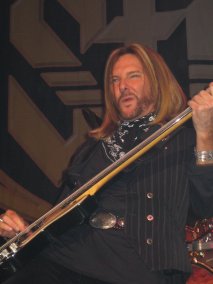 16. Renegade (Pieces of Eight, 1978) was performed as an entertaining 22?minute epic that began with a guitar duel between JY and TSh. TSh played a 15?second guitar solo. JY then motioned for TSh to get out of his way so he could step forward and shred. TSh followed JY by playing a second guitar solo. Finally, JY topped TSh with an impressive solo that prompted TSh to slightly kneel before JY and motion with his hands that he was bowing before the riffmeister.
16. Renegade (Pieces of Eight, 1978) was performed as an entertaining 22?minute epic that began with a guitar duel between JY and TSh. TSh played a 15?second guitar solo. JY then motioned for TSh to get out of his way so he could step forward and shred. TSh followed JY by playing a second guitar solo. Finally, JY topped TSh with an impressive solo that prompted TSh to slightly kneel before JY and motion with his hands that he was bowing before the riffmeister.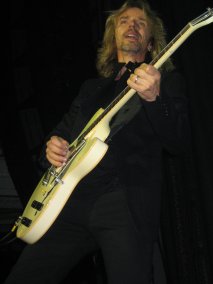 At the conclusion of Renegade, the band members left the stage but returned within one minute with black and white beach balls they kicked, threw and, in the case of LG, shot into the crowd using a hockey stick. Two flashback memories are worthy of mention. First, I recall being in middle school when Mr. Roboto from Kilroy was Here (1983) peaked at number three on the singles chart. A few of my yuppie classmates sat in the section of the cafeteria reserved for the “popular students.” These classmates were wearing their Izod shirts with collars raised and pastel?colored argyle sweaters draped over their backs with sleeves visible in criss cross patterns across their necks. Much to my annoyance, these classmates, who were sitting a few rows away, sang the chorus to Mr. Roboto at a loud volume and in a horrid pitch. I felt inclined to pick up the tater tots (i.e., side-dish made from deep-fried, grated potatoes) from my lunch tray and hurl them at their heads with great might, aiming for their foreheads with hopes the grease would make the tater tots stick and remain imbedded thereon, serving as makeshift bindis (i.e., small colored ornamental dots worn in the middle of a woman’s forehead, especially by the Hindu faith). However, I resisted the urge to prevent an automatic suspension by the principal. I then looked down and realized my anger has caused me to squish my tater tots, converting them to mash potato.
At the conclusion of Renegade, the band members left the stage but returned within one minute with black and white beach balls they kicked, threw and, in the case of LG, shot into the crowd using a hockey stick. Two flashback memories are worthy of mention. First, I recall being in middle school when Mr. Roboto from Kilroy was Here (1983) peaked at number three on the singles chart. A few of my yuppie classmates sat in the section of the cafeteria reserved for the “popular students.” These classmates were wearing their Izod shirts with collars raised and pastel?colored argyle sweaters draped over their backs with sleeves visible in criss cross patterns across their necks. Much to my annoyance, these classmates, who were sitting a few rows away, sang the chorus to Mr. Roboto at a loud volume and in a horrid pitch. I felt inclined to pick up the tater tots (i.e., side-dish made from deep-fried, grated potatoes) from my lunch tray and hurl them at their heads with great might, aiming for their foreheads with hopes the grease would make the tater tots stick and remain imbedded thereon, serving as makeshift bindis (i.e., small colored ornamental dots worn in the middle of a woman’s forehead, especially by the Hindu faith). However, I resisted the urge to prevent an automatic suspension by the principal. I then looked down and realized my anger has caused me to squish my tater tots, converting them to mash potato.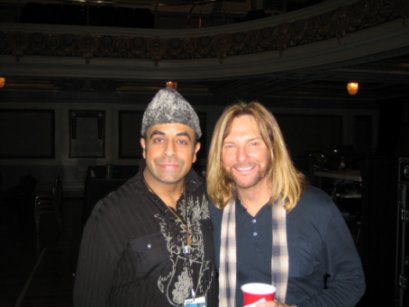
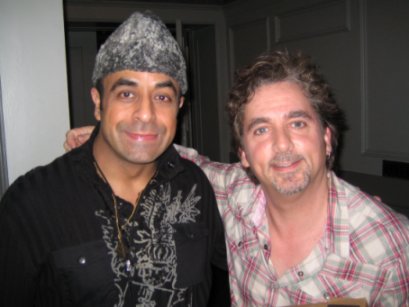
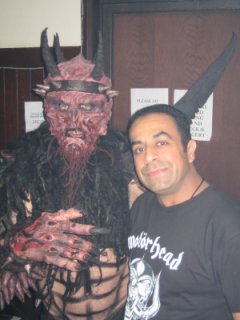
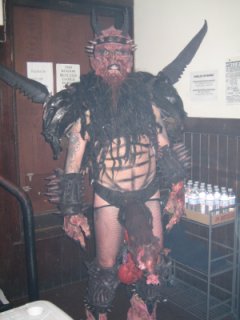
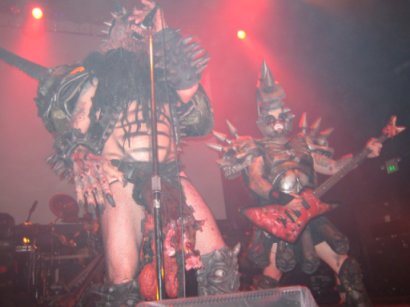
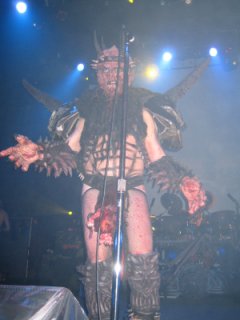
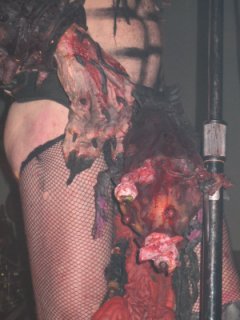
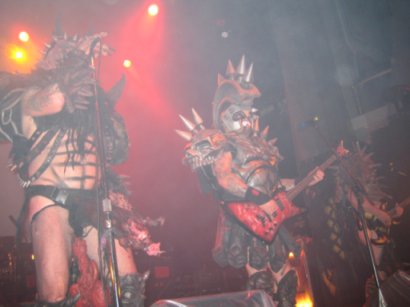
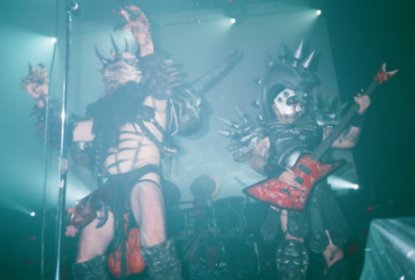
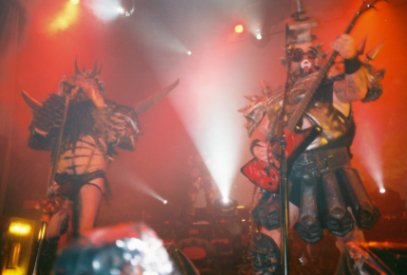
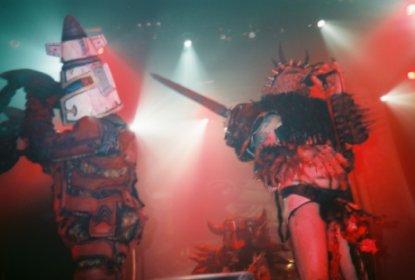
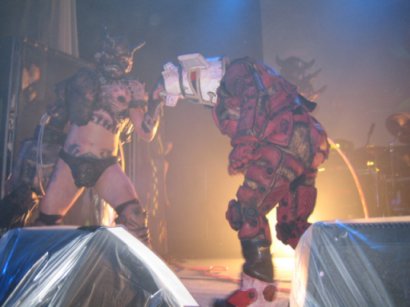
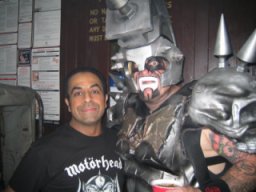 On November 24, 2009, Gwar decimated, desecrated, and devirginized the once pristine Regency Ballroom (“RB”). Gwar started the concert at 10:00. Technically speaking, Gwarmania began at 9:50 when the band showed a spoof Gwar documentary on the large projection screen behind the drum set that gave a history of the band interspersed with interviews with Oderus Urungus (“OU”) (lead singer, real name Dave Brockie). While the movie was playing, I quickly put on a one piece coverall under the mistaken belief it would protect me from Gwar slime. [The fact that my underwear, socks, and contact lenses were blood red when I arrived home nixed that theory.] Gwar played 16 songs discussed in greater detail below.
On November 24, 2009, Gwar decimated, desecrated, and devirginized the once pristine Regency Ballroom (“RB”). Gwar started the concert at 10:00. Technically speaking, Gwarmania began at 9:50 when the band showed a spoof Gwar documentary on the large projection screen behind the drum set that gave a history of the band interspersed with interviews with Oderus Urungus (“OU”) (lead singer, real name Dave Brockie). While the movie was playing, I quickly put on a one piece coverall under the mistaken belief it would protect me from Gwar slime. [The fact that my underwear, socks, and contact lenses were blood red when I arrived home nixed that theory.] Gwar played 16 songs discussed in greater detail below.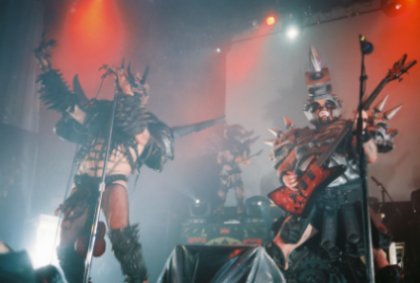
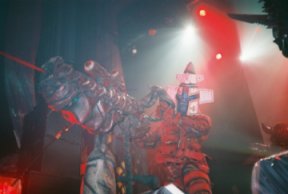 2. Saddam A Go Go (This Toilet Earth, 2004) featured a slave donning a rocket shaped helmet who appeared manning an archaic machine gun on a stand akin to one depicted in the “Mad Max” (1979) film. The slave doused the crowd with green slime. Since I was in the photo pit, I sought protection by ducking below stage height each time the slave turned and pointed the gun’s barrel at my quivering head.
2. Saddam A Go Go (This Toilet Earth, 2004) featured a slave donning a rocket shaped helmet who appeared manning an archaic machine gun on a stand akin to one depicted in the “Mad Max” (1979) film. The slave doused the crowd with green slime. Since I was in the photo pit, I sought protection by ducking below stage height each time the slave turned and pointed the gun’s barrel at my quivering head.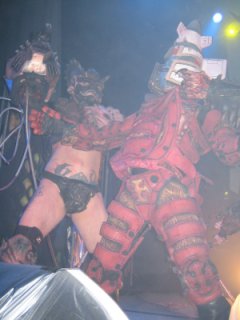 3. Lords and Masters (Lust in Space, 2009) is another fast up tempo song from Gwar’s most recent record. Two slaves appeared on stage. One slave sported an electric circular saw he used to cut the chest of the previously mentioned slave donning the rocket shaped helmet. This carnage caused the wounded slave’s chest to profusely bleed. Unfortunately, my earlier tactic of ducking below stage height miserably failed because the wounded slave lumbered and fell a few inches in front of me, past the tip of the stage. [I felt like a tiny rodent who had sought shelter by burrowing myself in an underground den but who had been sniffed out by a hungry salivating mongoose hovering above for his anticipated meal.]
3. Lords and Masters (Lust in Space, 2009) is another fast up tempo song from Gwar’s most recent record. Two slaves appeared on stage. One slave sported an electric circular saw he used to cut the chest of the previously mentioned slave donning the rocket shaped helmet. This carnage caused the wounded slave’s chest to profusely bleed. Unfortunately, my earlier tactic of ducking below stage height miserably failed because the wounded slave lumbered and fell a few inches in front of me, past the tip of the stage. [I felt like a tiny rodent who had sought shelter by burrowing myself in an underground den but who had been sniffed out by a hungry salivating mongoose hovering above for his anticipated meal.]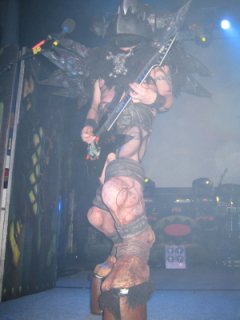
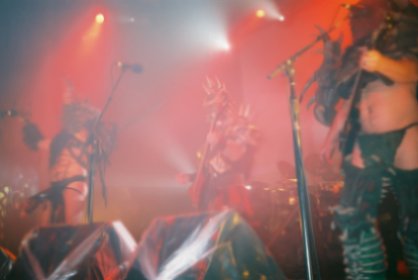
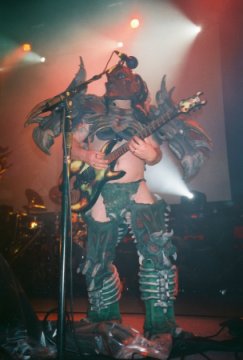 8. Let Us Slay (Lust in Space, 2009) is a solid mid tempo song performed with no antics.
8. Let Us Slay (Lust in Space, 2009) is a solid mid tempo song performed with no antics.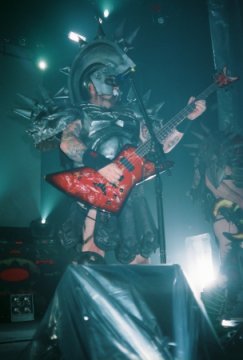 11. The Price of Peace (Lust in Space, 2009) featured Beefcake the Mighty (bassist, real name Casey Orr) on vocals. A 15 foot futuristic white robot with jagged teeth and eyes that lit up with white light stiltedly appeared. The slave with the electric circular saw and another holding an oversized sword confronted the robot. The robot used his massive forearms to knock the slaves around like miniature action figures. The sword wielding slave eventually impaled his weapon in the robot’s chest, causing the protective shield to fall off and a fetus to drop from within and dangle by its umbilical cord. Acting much like a tag team wrestling duo, the victorious slave and OU violently ripped the alien’s forearms off his body, causing the dangling ends of the robot’s upper arms to spew blood into the crowd. OU then finished the festivities by impaling the alien with his Conan the Barbarian sized sword. His slave henchman pulled the sword out and the alien hobbled off stage.
11. The Price of Peace (Lust in Space, 2009) featured Beefcake the Mighty (bassist, real name Casey Orr) on vocals. A 15 foot futuristic white robot with jagged teeth and eyes that lit up with white light stiltedly appeared. The slave with the electric circular saw and another holding an oversized sword confronted the robot. The robot used his massive forearms to knock the slaves around like miniature action figures. The sword wielding slave eventually impaled his weapon in the robot’s chest, causing the protective shield to fall off and a fetus to drop from within and dangle by its umbilical cord. Acting much like a tag team wrestling duo, the victorious slave and OU violently ripped the alien’s forearms off his body, causing the dangling ends of the robot’s upper arms to spew blood into the crowd. OU then finished the festivities by impaling the alien with his Conan the Barbarian sized sword. His slave henchman pulled the sword out and the alien hobbled off stage.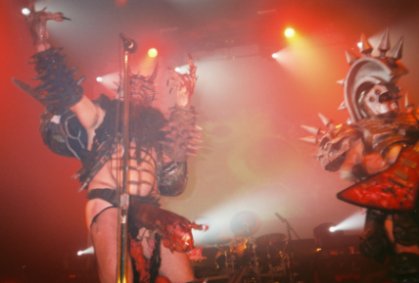
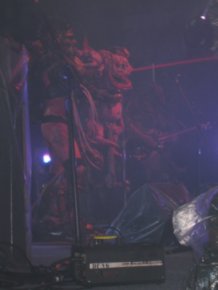 14. Jack the World (This Toilet Earth, 2004) was performed with no antics.
14. Jack the World (This Toilet Earth, 2004) was performed with no antics.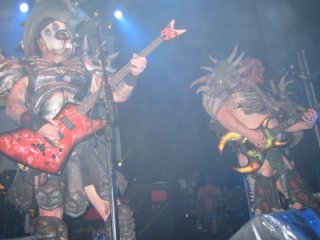 First, I was reminded of Judas Priest’s show at the Oakland Arena during the Turbo tour (05 15 86). Like Priest, Gwar performed six songs off their new record. No disrespect to the mighty Priest, but being an avid thrash fan means Turbo’s light, synthesized tinged sound is my least favorite Priest record. I came close to performing hari kari (i.e., ceremonial suicide by ripping open the abdomen with a dagger) by the time the band performed the sixth song off Turbo. Fortunately, my plastic hot dog stand knife was as dull as my brain after taking a lengthy standardized aptitude test designed to gauge my I.Q. or, more aptly, lack thereof. In contrast, I enjoyed hearing six songs off Lust in Space because of the thrash induced feel of the songs.
First, I was reminded of Judas Priest’s show at the Oakland Arena during the Turbo tour (05 15 86). Like Priest, Gwar performed six songs off their new record. No disrespect to the mighty Priest, but being an avid thrash fan means Turbo’s light, synthesized tinged sound is my least favorite Priest record. I came close to performing hari kari (i.e., ceremonial suicide by ripping open the abdomen with a dagger) by the time the band performed the sixth song off Turbo. Fortunately, my plastic hot dog stand knife was as dull as my brain after taking a lengthy standardized aptitude test designed to gauge my I.Q. or, more aptly, lack thereof. In contrast, I enjoyed hearing six songs off Lust in Space because of the thrash induced feel of the songs.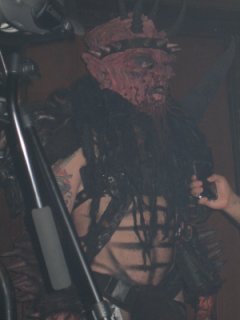 Second, I watched in fascination backstage pre show at the fruitless efforts by two socially awkward and technically inept wanna be rockers setting up equipment for an on camera, interview with OU. The tiny cramped backstage area was riddled with camera equipment, including a tri pod, oversized camera, and yards of cable. The cameraman sported a spiked blonde mohawk but had the mannerisms of Beavis from the American animated television series “Beavis and Butt-Head” (1993-1997). The interviewer resembled Butt-Head or a Dungeons & Dragons fantasy role-playing game aficionado. Cameraman Beavis repeatedly scurried back and forth from behind the camera, intensely looking into the eyepiece as if he was Steven Spielberg. Interviewer Butt Head awkwardly stood a few feet in front of the camera nervously awaiting OU’s arrival. As it turns out, the hapless dimwits were unable to get the camera to function. Interviewer Butt Head had a brilliant idea, conduct the interview with his iphone. When OU walked into the room and saw a tri pod with no camera and interviewer Butt Head sticking an iphone in his face, he said in shock, “You want to do this on camera interview with an iphone?!” OU should have told cameraman Beavis and interviewer Butt Head they were Gwar’s VIP guests for the night and instructed them to hang out side stage. Then, right before Gwar took the stage and while the eager rabid fans were salivating over the anticipated onslaught, OU should have instructed Gwar slaves to manhandle the two fans by stripping them of all their clothes and dousing them in red and green slime, making them look like festive candy canes.
Second, I watched in fascination backstage pre show at the fruitless efforts by two socially awkward and technically inept wanna be rockers setting up equipment for an on camera, interview with OU. The tiny cramped backstage area was riddled with camera equipment, including a tri pod, oversized camera, and yards of cable. The cameraman sported a spiked blonde mohawk but had the mannerisms of Beavis from the American animated television series “Beavis and Butt-Head” (1993-1997). The interviewer resembled Butt-Head or a Dungeons & Dragons fantasy role-playing game aficionado. Cameraman Beavis repeatedly scurried back and forth from behind the camera, intensely looking into the eyepiece as if he was Steven Spielberg. Interviewer Butt Head awkwardly stood a few feet in front of the camera nervously awaiting OU’s arrival. As it turns out, the hapless dimwits were unable to get the camera to function. Interviewer Butt Head had a brilliant idea, conduct the interview with his iphone. When OU walked into the room and saw a tri pod with no camera and interviewer Butt Head sticking an iphone in his face, he said in shock, “You want to do this on camera interview with an iphone?!” OU should have told cameraman Beavis and interviewer Butt Head they were Gwar’s VIP guests for the night and instructed them to hang out side stage. Then, right before Gwar took the stage and while the eager rabid fans were salivating over the anticipated onslaught, OU should have instructed Gwar slaves to manhandle the two fans by stripping them of all their clothes and dousing them in red and green slime, making them look like festive candy canes.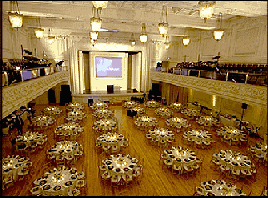 Venue: the building that housed the original RB, known as the Avalon Ballroom, was built in 1911. The Avalon Ballroom operated from 1966-68 and reopened in 2003 under its current name. During the ballroom’s original stint in the 1960’s local bands such as Janis Joplin, Quicksilver Messenger Service, the Steve Miller Band, and Big Brother and the Holding Company performed at this venue. RB is a 1,050 seat capacity theater with a rectangular shaped standing room floor measuring 96 by 69 feet with blonde hardwood floors and a permanent stage measuring 42 by 20 feet. Positioned 35 feet above the floor are 22 teardrop chandeliers circa 1900 secured on a roof adorned with gold medallions. RB has a horseshoe-shaped reserved seating balcony, the interior siding of which visible from the floor is virgin white. Four vertical white columns line the wall atop the stage and another six are present on each of the walls on the second floor. Also lining the side walls on each floor are six square shaped gold colored tapestries. [The more timid fans not enthused with being hosed by Gwar sludge took refuge on the second floor, hoping the liquid concoction could not reach them. However, the fact that a large portion of the balcony balustrade was lined with protective clear plastic should have provided ample notice that only the extreme regions of RB opposite the stage were safe from the gore fest about to ensue.]
Venue: the building that housed the original RB, known as the Avalon Ballroom, was built in 1911. The Avalon Ballroom operated from 1966-68 and reopened in 2003 under its current name. During the ballroom’s original stint in the 1960’s local bands such as Janis Joplin, Quicksilver Messenger Service, the Steve Miller Band, and Big Brother and the Holding Company performed at this venue. RB is a 1,050 seat capacity theater with a rectangular shaped standing room floor measuring 96 by 69 feet with blonde hardwood floors and a permanent stage measuring 42 by 20 feet. Positioned 35 feet above the floor are 22 teardrop chandeliers circa 1900 secured on a roof adorned with gold medallions. RB has a horseshoe-shaped reserved seating balcony, the interior siding of which visible from the floor is virgin white. Four vertical white columns line the wall atop the stage and another six are present on each of the walls on the second floor. Also lining the side walls on each floor are six square shaped gold colored tapestries. [The more timid fans not enthused with being hosed by Gwar sludge took refuge on the second floor, hoping the liquid concoction could not reach them. However, the fact that a large portion of the balcony balustrade was lined with protective clear plastic should have provided ample notice that only the extreme regions of RB opposite the stage were safe from the gore fest about to ensue.] As you walk through the entrance and go through a narrow hallway you immediately end up on the general admission floor approximately 10 feet stage left. The stage measures approximately 30 feet across and only four feet high with no photo pit. The bar is located opposite the stage. TI has a second floor that includes quasi box seat sections stage right (eight- to 10 seat capacity) and stage left (three- to four seat capacity), as well as a mixing console across the stage. [The box seats are not as grandiose as the ones located in a traditional theater and more resemble wooden structures perched atop a tree house. The venue size gives TI more of a square than a rectangular shape, making it ideal for (1) a cock fight contest or (2) the chap toting, beer swigging redneck brigade to raise a raucous line dancing. For these reasons, and the shady neighborhood, if UFO was really an alien ship, I am hard pressed to believe it would have taken a gander at this venue, much less went inside.] However, the intimate venue size, low raised stage, and lack of photo pit afford an opportunity to get close to performers. For this reason, I have not passed up opportunities to see acts such as Yngwie Malmsteen, Blackmore’s Night, Testament, and Y&T at TI.
As you walk through the entrance and go through a narrow hallway you immediately end up on the general admission floor approximately 10 feet stage left. The stage measures approximately 30 feet across and only four feet high with no photo pit. The bar is located opposite the stage. TI has a second floor that includes quasi box seat sections stage right (eight- to 10 seat capacity) and stage left (three- to four seat capacity), as well as a mixing console across the stage. [The box seats are not as grandiose as the ones located in a traditional theater and more resemble wooden structures perched atop a tree house. The venue size gives TI more of a square than a rectangular shape, making it ideal for (1) a cock fight contest or (2) the chap toting, beer swigging redneck brigade to raise a raucous line dancing. For these reasons, and the shady neighborhood, if UFO was really an alien ship, I am hard pressed to believe it would have taken a gander at this venue, much less went inside.] However, the intimate venue size, low raised stage, and lack of photo pit afford an opportunity to get close to performers. For this reason, I have not passed up opportunities to see acts such as Yngwie Malmsteen, Blackmore’s Night, Testament, and Y&T at TI.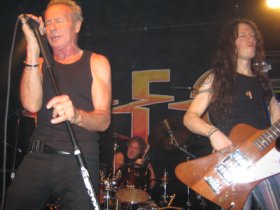 1. Saving Me (The Visitor record, 2009). The show started out with background music that was the introduction to the first song off UFO’s new (and 20th) studio record released in June 2009. I give credit to UFO for having the courage to start a show not only with a new song, one that most fans are not familiar with, but also one that is mid tempo with an acoustic introduction that Vinnie Moore (“VM”) played on a guitar propped on a stand a la “Beyond the Realms of Death” by the mighty Judas Priest. [I would have preferred if the show started with a song powerful enough to sheer the skin off my face or, at the very least, pummel my brain to the point where I can only speak in monosyllables.] This song is very bluesy with a strong guitar riff, solid drum beat, and an acoustic guitar solo. At the end of the song, Phil Mogg (“PM”) pulled a note out of his pocket and extended “Happy Birthday to Bob.” [Two questions popped in my head. First, why on earth would PM need to keep a note to remember a name as simple and short as Bob. The only simpler name I can think of is Ed. Second, what would be the most efficient and clandestine means for me to hunt down Bob and shove my combat boot up his butt for interrupting the momentum so early in the gig.]
1. Saving Me (The Visitor record, 2009). The show started out with background music that was the introduction to the first song off UFO’s new (and 20th) studio record released in June 2009. I give credit to UFO for having the courage to start a show not only with a new song, one that most fans are not familiar with, but also one that is mid tempo with an acoustic introduction that Vinnie Moore (“VM”) played on a guitar propped on a stand a la “Beyond the Realms of Death” by the mighty Judas Priest. [I would have preferred if the show started with a song powerful enough to sheer the skin off my face or, at the very least, pummel my brain to the point where I can only speak in monosyllables.] This song is very bluesy with a strong guitar riff, solid drum beat, and an acoustic guitar solo. At the end of the song, Phil Mogg (“PM”) pulled a note out of his pocket and extended “Happy Birthday to Bob.” [Two questions popped in my head. First, why on earth would PM need to keep a note to remember a name as simple and short as Bob. The only simpler name I can think of is Ed. Second, what would be the most efficient and clandestine means for me to hunt down Bob and shove my combat boot up his butt for interrupting the momentum so early in the gig.]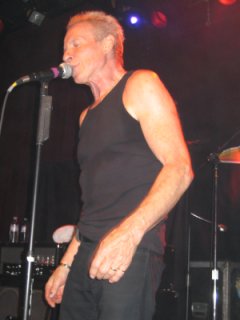 2. Daylight Goes to Town (You Are Here, 2004) features soulful vocal performance by PM. PM wore black jean pants, black jean jacket, black tank top, and black boots that he laced up above him cuffs. [PM was the rock version of Johnny Cash, only much leaner and fit, surprising given the amount of beer he consumed (see below).]
2. Daylight Goes to Town (You Are Here, 2004) features soulful vocal performance by PM. PM wore black jean pants, black jean jacket, black tank top, and black boots that he laced up above him cuffs. [PM was the rock version of Johnny Cash, only much leaner and fit, surprising given the amount of beer he consumed (see below).]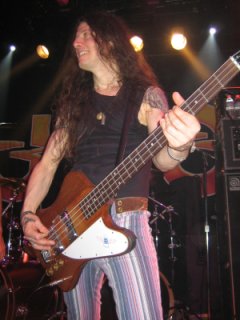 5. I’m A Loser (No Heavy Petting, 1976) features a slow introduction and then progresses to an upbeat tempo. This song has a groovy, punchy bass line faithfully delivered by Rob De Luca (“RDL”). RDL, a New Yorker, formerly of Sebastian Bach’s band, filled in for the ill Pete Way. RDL wore a black muscle t shirt, brown boots, and vintage vertical striped (grey, red, and blue) slacks. [RDL told me post show his slacks were inspired by the Pete Way school of fashion.] Paul Raymond (“PR”) played his Korg and Roland keyboards. At the end of the song PM told another incoherent joke. [I felt as if I was watching the opening monologue of a re run episode of the classic 1970s British comedy show, “Benny Hill.”]
5. I’m A Loser (No Heavy Petting, 1976) features a slow introduction and then progresses to an upbeat tempo. This song has a groovy, punchy bass line faithfully delivered by Rob De Luca (“RDL”). RDL, a New Yorker, formerly of Sebastian Bach’s band, filled in for the ill Pete Way. RDL wore a black muscle t shirt, brown boots, and vintage vertical striped (grey, red, and blue) slacks. [RDL told me post show his slacks were inspired by the Pete Way school of fashion.] Paul Raymond (“PR”) played his Korg and Roland keyboards. At the end of the song PM told another incoherent joke. [I felt as if I was watching the opening monologue of a re run episode of the classic 1970s British comedy show, “Benny Hill.”]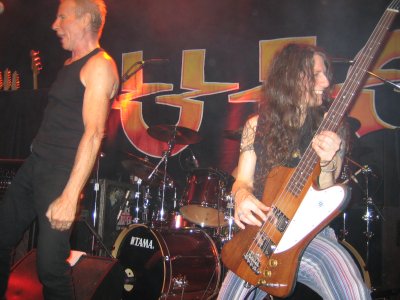
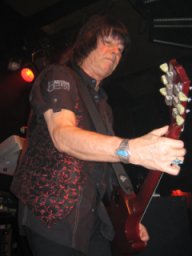 8. Only You Can Rock Me (Obsession, 1978) features prominent keyboard by PR, making it a poppier song but still with a strong drum beat. PR wore black jean pants, a short sleeve button up black shirt, black satin vest with a burgundy floral pattern, and black sneakers. PR is a talented guitarist and keyboardist. His laid back lackadaisical stage persona is in sharp contrast to his band mates. [But then again, so was that of John Entwistle in comparison to the over the top antics of Roger Daltrey, Keith Moon, and Pete Townshend of The Who.]
8. Only You Can Rock Me (Obsession, 1978) features prominent keyboard by PR, making it a poppier song but still with a strong drum beat. PR wore black jean pants, a short sleeve button up black shirt, black satin vest with a burgundy floral pattern, and black sneakers. PR is a talented guitarist and keyboardist. His laid back lackadaisical stage persona is in sharp contrast to his band mates. [But then again, so was that of John Entwistle in comparison to the over the top antics of Roger Daltrey, Keith Moon, and Pete Townshend of The Who.]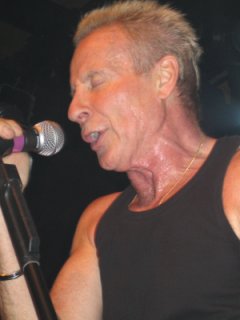 11. Mystery Train (Junior Parker/Sam Phillips cover, 1953) is a cover song from nearly 60 years ago with a very strong blues feel and clap along introduction. PM sang this song in a very low octave, so much so that the veins in his left temple were prominently exposed. [The veins were so apparent that PM looked like one of the victims in the 1981 horror film “Scanners” with the unfortunate fate of having his mind controlled by the scanner alien beings bearing great psychic power. I was waiting for PM’s temple to profusely bleed and eventually explode. Maybe that is why PM drank so much beer, to numb his brain to the point that it did not explode, something that may also work for me when my brain begins to feel warm, like a poached egg after continued, excessive head banging.] The song also featured harmonica. At first I was puzzled as I did not see any band mate toting a harmonica. But I looked up and saw PR synthesizing this effect on his keyboard. [It would have been more authentic to see PM pull out a harmonica out of his pocket.] At the end of this song a waitress toting a small plate with a beer walked right next to me front row and handed PM another beer. PM approached her with the currency he had earlier taken out and the waitress begrudgingly accepted the money.
11. Mystery Train (Junior Parker/Sam Phillips cover, 1953) is a cover song from nearly 60 years ago with a very strong blues feel and clap along introduction. PM sang this song in a very low octave, so much so that the veins in his left temple were prominently exposed. [The veins were so apparent that PM looked like one of the victims in the 1981 horror film “Scanners” with the unfortunate fate of having his mind controlled by the scanner alien beings bearing great psychic power. I was waiting for PM’s temple to profusely bleed and eventually explode. Maybe that is why PM drank so much beer, to numb his brain to the point that it did not explode, something that may also work for me when my brain begins to feel warm, like a poached egg after continued, excessive head banging.] The song also featured harmonica. At first I was puzzled as I did not see any band mate toting a harmonica. But I looked up and saw PR synthesizing this effect on his keyboard. [It would have been more authentic to see PM pull out a harmonica out of his pocket.] At the end of this song a waitress toting a small plate with a beer walked right next to me front row and handed PM another beer. PM approached her with the currency he had earlier taken out and the waitress begrudgingly accepted the money.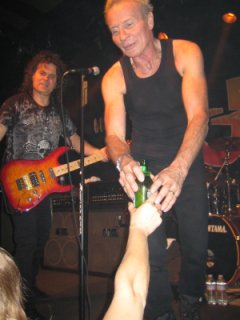 12. Too Hot to Handle (Lights Out, 1977) features a great chorus and was one of the top three songs of the night. During the solo VM and RDL each lifted and positioned their axes behind their heads and then approached each other, standing within a few feet of each other while jamming. After about 30 seconds of dueling axes, VM took it a step further and began to pluck his guitar strings with his teeth. [Jimi Hendrix would have been proud. I wonder if VM’s band mates ever tease him by offering him a high E-string in lieu of dental floss once he gets in his jammies.] Positioned atop the monitor within a few feet of AP’s left shoulder was a colorful toy figurine measuring approximately three inches holding a guitar and gyrating his hips left and right like Elvis Presley in response to the sound reverberating through the small club. A very fitting addition to the band’s tongue in cheek humor. [Given AP’s husky frame, he looked like King Kong next to the figurine. AP’s menacing snarl, teeth grinding, and head shaking made it seem as if, at any moment, he would snatch the figurine and engulf it in one bite like a gummy bear.] At the end of the song PM pontificated, “Since this is the last gig [before UFO resumes the tour in Europe in mid November], I asked the band their thoughts on playing in a band. As it turns out, they all think different things.” [One of the readers out there please e mail me the point PM tried to make. I felt like I was listening to Confucius. PM’s eternal wisdom was far beyond what my miniscule brain could handle. I am still grappling and contemplating the difficult question of the true shape of my fuzzy navel.]
12. Too Hot to Handle (Lights Out, 1977) features a great chorus and was one of the top three songs of the night. During the solo VM and RDL each lifted and positioned their axes behind their heads and then approached each other, standing within a few feet of each other while jamming. After about 30 seconds of dueling axes, VM took it a step further and began to pluck his guitar strings with his teeth. [Jimi Hendrix would have been proud. I wonder if VM’s band mates ever tease him by offering him a high E-string in lieu of dental floss once he gets in his jammies.] Positioned atop the monitor within a few feet of AP’s left shoulder was a colorful toy figurine measuring approximately three inches holding a guitar and gyrating his hips left and right like Elvis Presley in response to the sound reverberating through the small club. A very fitting addition to the band’s tongue in cheek humor. [Given AP’s husky frame, he looked like King Kong next to the figurine. AP’s menacing snarl, teeth grinding, and head shaking made it seem as if, at any moment, he would snatch the figurine and engulf it in one bite like a gummy bear.] At the end of the song PM pontificated, “Since this is the last gig [before UFO resumes the tour in Europe in mid November], I asked the band their thoughts on playing in a band. As it turns out, they all think different things.” [One of the readers out there please e mail me the point PM tried to make. I felt like I was listening to Confucius. PM’s eternal wisdom was far beyond what my miniscule brain could handle. I am still grappling and contemplating the difficult question of the true shape of my fuzzy navel.]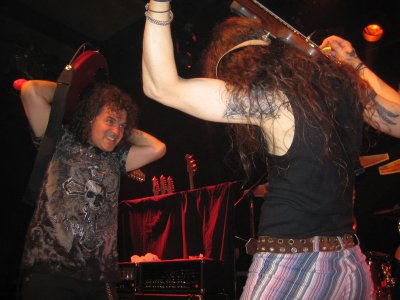
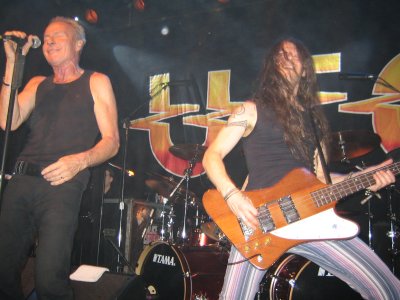
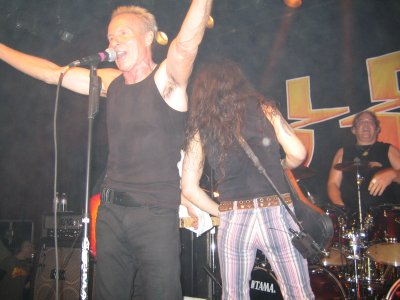
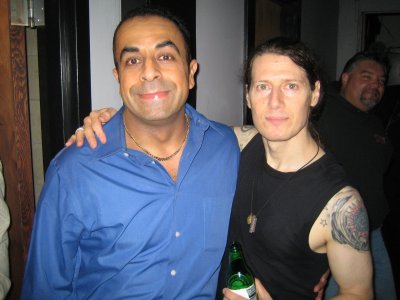
 Non stop, jack rabbit virgin sex is the best phrase I can use to describe the pace of Alice Cooper’s (“AC’s”) set. AC’s band, that includes Keri Kelli (“KK”) and Damon Johnson (“DJ”) on guitar, Chuck Garric (“CG”) on bass, and Jimmy DeGrasso (“JD”) on drums, bulldozed through 26 songs in one hour and 25 minutes before the encore break. No pause between songs, not even the ubiquitous utterance of “How ya’ doin’ San Francisco?!” It was like the testosterone laced first sexual experience of a young teenager relying on the sketches in Alex Comfort’s book, “The Joy of Sex” to make sure he gets it right. No chit chatter, no pause, just the frenetic pace of jack rabbits doing the dirty deed. When it is over you are not sure what just hit you, but whatever it was it felt good, albeit a bit strange. In the case of an awkward first sexual experience, what hits you is the “big O.” In the case of what transpired at the hallowed Warfield Theater (“WT”), it was a mix of P. T. Barnum and shock rock and roll.
Non stop, jack rabbit virgin sex is the best phrase I can use to describe the pace of Alice Cooper’s (“AC’s”) set. AC’s band, that includes Keri Kelli (“KK”) and Damon Johnson (“DJ”) on guitar, Chuck Garric (“CG”) on bass, and Jimmy DeGrasso (“JD”) on drums, bulldozed through 26 songs in one hour and 25 minutes before the encore break. No pause between songs, not even the ubiquitous utterance of “How ya’ doin’ San Francisco?!” It was like the testosterone laced first sexual experience of a young teenager relying on the sketches in Alex Comfort’s book, “The Joy of Sex” to make sure he gets it right. No chit chatter, no pause, just the frenetic pace of jack rabbits doing the dirty deed. When it is over you are not sure what just hit you, but whatever it was it felt good, albeit a bit strange. In the case of an awkward first sexual experience, what hits you is the “big O.” In the case of what transpired at the hallowed Warfield Theater (“WT”), it was a mix of P. T. Barnum and shock rock and roll.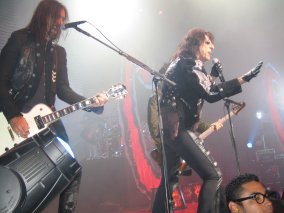 On October 21, 2009, AC brought his entertaining vaudevillian circus to WT. For those of you who have read my review of the Motorhead show at WT from earlier in the month, I ask for your indulgence in repeating a brief history for this historic venue. WT, where Slayer filmed its classic DVD entitled, War at the Warfield during the God Hates Us All tour (12-07-01), is a 2,500 seat capacity theater built in 1927 and renovated in September 2008. WT’s layout presents a dichotomy. On the one hand, the theater’s beauty is exemplified by intricate frescos of matadors and angels painted on the ceiling atop the stage. Box seats that have long been put out of use adorn each side of the stage and the walls of the seated balcony are a vibrant plum red and gold combination. On the other hand, the standing room only floor has a stark industrial feel with black walls and floor. The walls are carpet padded, serving a safety function for your injury prone writer who trounced around like a whirling dervish at Slayer and Megadeth shows.
On October 21, 2009, AC brought his entertaining vaudevillian circus to WT. For those of you who have read my review of the Motorhead show at WT from earlier in the month, I ask for your indulgence in repeating a brief history for this historic venue. WT, where Slayer filmed its classic DVD entitled, War at the Warfield during the God Hates Us All tour (12-07-01), is a 2,500 seat capacity theater built in 1927 and renovated in September 2008. WT’s layout presents a dichotomy. On the one hand, the theater’s beauty is exemplified by intricate frescos of matadors and angels painted on the ceiling atop the stage. Box seats that have long been put out of use adorn each side of the stage and the walls of the seated balcony are a vibrant plum red and gold combination. On the other hand, the standing room only floor has a stark industrial feel with black walls and floor. The walls are carpet padded, serving a safety function for your injury prone writer who trounced around like a whirling dervish at Slayer and Megadeth shows.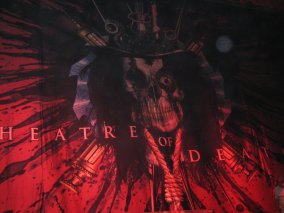 AC was supported by Jetboy, a San Francisco based rock band formed in 1983. Jetboy played a 40-minute set from 8:00 to 8:40. Following Jetboy’s set an expansive curtain was raised stage front, featuring a likeness of AC’s head as a skull along with the phrase, “Theater of Death.” After a 35 minute set change the curtain dropped at 9:15. Hanging individually from the ceiling at varying distances from front stage, were five letters that read, “A” “L” “I” “C” “E.” Each red colored letter was made of velvet, ranging from three to 10 feet in height, with a black border encased by a white border. Even though the logo obstructed the view for some fans it added to the carnival like atmosphere depicting the stage as an LSD induced birthday party from the summer of love (1967). [The only thing missing was for a junkie Bozo the Clown to stumble on stage munching on a magic shroom.]
AC was supported by Jetboy, a San Francisco based rock band formed in 1983. Jetboy played a 40-minute set from 8:00 to 8:40. Following Jetboy’s set an expansive curtain was raised stage front, featuring a likeness of AC’s head as a skull along with the phrase, “Theater of Death.” After a 35 minute set change the curtain dropped at 9:15. Hanging individually from the ceiling at varying distances from front stage, were five letters that read, “A” “L” “I” “C” “E.” Each red colored letter was made of velvet, ranging from three to 10 feet in height, with a black border encased by a white border. Even though the logo obstructed the view for some fans it added to the carnival like atmosphere depicting the stage as an LSD induced birthday party from the summer of love (1967). [The only thing missing was for a junkie Bozo the Clown to stumble on stage munching on a magic shroom.]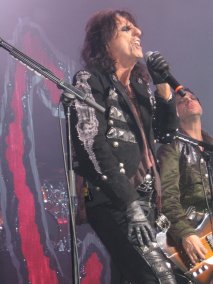 For the benefit of providing a full picture of the freak show, I enumerate all 26 songs AC performed. [The hardcore Cooper fans should appreciate a detailed account, including theatrics, not a skimpy mention of a half dozen songs as if I was doing the 11 o’clock Sunday night sports wrap of the day’s football matches.]
For the benefit of providing a full picture of the freak show, I enumerate all 26 songs AC performed. [The hardcore Cooper fans should appreciate a detailed account, including theatrics, not a skimpy mention of a half dozen songs as if I was doing the 11 o’clock Sunday night sports wrap of the day’s football matches.]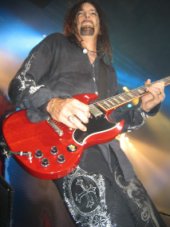 2. Department of Youth (Welcome to My Nightmare, 1975) was an excellent choice for the second song because it is a chant song with audience participation. AC played seven songs off Welcome to My Nightmare. During the last eight or so years it has become popular for artists to play a seminal catalog record in its entirety. AC’s Theater of Death tour was not such a tour for Welcome to My Nightmare, making it uncommon to hear seven songs off this record. [The last time I recall a band performing so many songs off one record was Judas Priest performing six songs off Turbo during the Turbo tour.]
2. Department of Youth (Welcome to My Nightmare, 1975) was an excellent choice for the second song because it is a chant song with audience participation. AC played seven songs off Welcome to My Nightmare. During the last eight or so years it has become popular for artists to play a seminal catalog record in its entirety. AC’s Theater of Death tour was not such a tour for Welcome to My Nightmare, making it uncommon to hear seven songs off this record. [The last time I recall a band performing so many songs off one record was Judas Priest performing six songs off Turbo during the Turbo tour.]
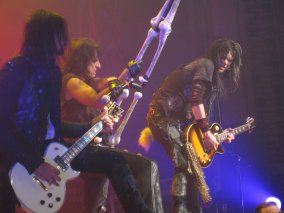 3. I’m Eighteen (Love It to Death, 1971), one of AC’s biggest hits, was a surprising song to hear so early in the set. Regardless, it featured great guitar solos by DJ and KK. DJ wore black jeans with a silver skull pattern, long sleeve black shirt with frilly French cuffs. AC walked around holding a crutch comprised of, what else, skeleton bones. [Had I known bones played such a prominent role in the show I would have snuck in a bucket of Kentucky Fried Chicken, gnawed on the meat, and tossed the bone fragments on stage.]
3. I’m Eighteen (Love It to Death, 1971), one of AC’s biggest hits, was a surprising song to hear so early in the set. Regardless, it featured great guitar solos by DJ and KK. DJ wore black jeans with a silver skull pattern, long sleeve black shirt with frilly French cuffs. AC walked around holding a crutch comprised of, what else, skeleton bones. [Had I known bones played such a prominent role in the show I would have snuck in a bucket of Kentucky Fried Chicken, gnawed on the meat, and tossed the bone fragments on stage.]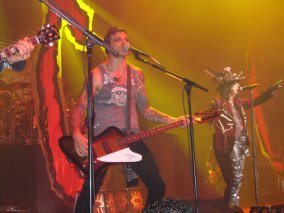 5. Ballad of Dwight Fry (Love It to Death, 1971). AC sang this ballad while sitting center stage wearing a burgundy straight jacket. KK, who wore black jeans, black denim vest, and a black t-shirt, played an acoustic guitar. At the end of the song a black hooded henchman placed AC in a guillotine and performed a mock execution. A few seconds later AC appeared from behind the guillotine and pulled out what was supposedly his severed head and held it high in the sky as if holding Medusa’s head.
5. Ballad of Dwight Fry (Love It to Death, 1971). AC sang this ballad while sitting center stage wearing a burgundy straight jacket. KK, who wore black jeans, black denim vest, and a black t-shirt, played an acoustic guitar. At the end of the song a black hooded henchman placed AC in a guillotine and performed a mock execution. A few seconds later AC appeared from behind the guillotine and pulled out what was supposedly his severed head and held it high in the sky as if holding Medusa’s head.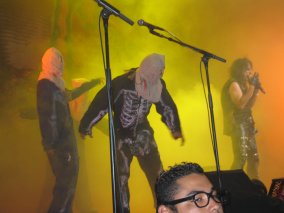 7. Guilty (Alice Cooper Goes to Hell, 1976) is a chugging song that featured a voodoo vibe. AC wore a suede burgundy jacket with an armadillo leather patch across his entire back, large skull bones attached to both sides of the chest, and a black top hat with long feathers.
7. Guilty (Alice Cooper Goes to Hell, 1976) is a chugging song that featured a voodoo vibe. AC wore a suede burgundy jacket with an armadillo leather patch across his entire back, large skull bones attached to both sides of the chest, and a black top hat with long feathers.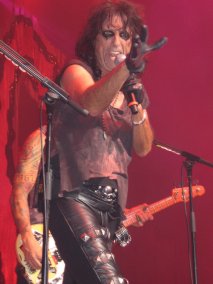 10. Poison (Trash, 1989) was next, the only song from the 1980s and my least favorite. Poison is too poppy and formulaic. Poison epitomizes what was wrong with a lot of rock music from the late 1980s, musicians who became corporate whores, allowed the executives (suits) who could not distinguish between Iron Butterfly and Iron Maiden to dictate how to write songs that would get airplay on radio and MTV’s “Headbanger’s Ball” television show. This logic did allow for short term commercial success for the greedy and misguided artists, but meant artist compromise, alienating dedicated fan bases. At the end of the song two hooded henchmen along with female nurse in a skimpy white outfit came on stage and “injected” AC with a gargantuan hypodermic needle.
10. Poison (Trash, 1989) was next, the only song from the 1980s and my least favorite. Poison is too poppy and formulaic. Poison epitomizes what was wrong with a lot of rock music from the late 1980s, musicians who became corporate whores, allowed the executives (suits) who could not distinguish between Iron Butterfly and Iron Maiden to dictate how to write songs that would get airplay on radio and MTV’s “Headbanger’s Ball” television show. This logic did allow for short term commercial success for the greedy and misguided artists, but meant artist compromise, alienating dedicated fan bases. At the end of the song two hooded henchmen along with female nurse in a skimpy white outfit came on stage and “injected” AC with a gargantuan hypodermic needle.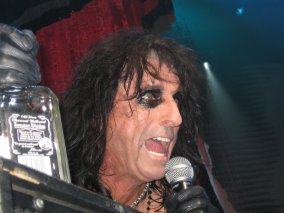 11. The Awakening (Welcome to My Nightmare, 1975) is a ballad that AC sang while on his knees.
11. The Awakening (Welcome to My Nightmare, 1975) is a ballad that AC sang while on his knees.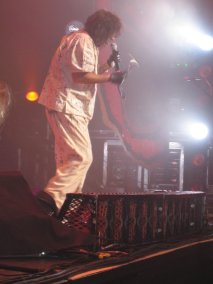 13. Nurse Rozetta (From the Inside, 1978) featured AC singing from a wheelchair and a muddled and sloppy chorus. AC wore a white shirt and white pants bearing the phrase “Asylum” on his chest and repetitive small size cross emblems. The female nurse stood on a platform grinding an electric sander against a stone attached atop her, ahem, sensitive region, causing sparks to fly. The nurse then took AC’s temperature and listened to his lungs with her stethoscope. AC miraculously got up from the wheelchair and grabbed the stethoscope from the nurse, tossing it around during the remainder of the song.
13. Nurse Rozetta (From the Inside, 1978) featured AC singing from a wheelchair and a muddled and sloppy chorus. AC wore a white shirt and white pants bearing the phrase “Asylum” on his chest and repetitive small size cross emblems. The female nurse stood on a platform grinding an electric sander against a stone attached atop her, ahem, sensitive region, causing sparks to fly. The nurse then took AC’s temperature and listened to his lungs with her stethoscope. AC miraculously got up from the wheelchair and grabbed the stethoscope from the nurse, tossing it around during the remainder of the song.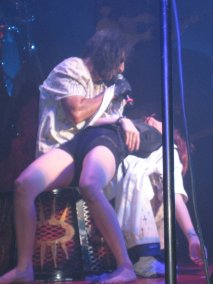 16. Only Women Bleed (Welcome to My Nightmare, 1975) is a ballad that featured an acoustic guitar and AC singing atop the lion stand while holding the limp body of the unconscious nurse on his lap. Halfway through the song AC threw the nurse off his lap and removed her red colored wig. The nurse regained consciousness. AC put the wig on his head and stood over the nurse. With a frightened look on her face and on her knees, the nurse pleaded for mercy. Three black hooded henchmen grabbed AC from behind and forced him to a stand bearing a noose. At this point, Only Women Bleed led straight into I Never Cry.
16. Only Women Bleed (Welcome to My Nightmare, 1975) is a ballad that featured an acoustic guitar and AC singing atop the lion stand while holding the limp body of the unconscious nurse on his lap. Halfway through the song AC threw the nurse off his lap and removed her red colored wig. The nurse regained consciousness. AC put the wig on his head and stood over the nurse. With a frightened look on her face and on her knees, the nurse pleaded for mercy. Three black hooded henchmen grabbed AC from behind and forced him to a stand bearing a noose. At this point, Only Women Bleed led straight into I Never Cry.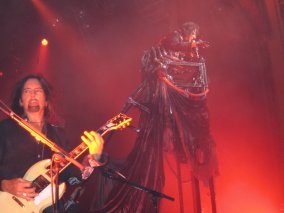 19. Vengeance is Mine (Along Came A Spider, 2008) featured AC singing song from a ridiculously tall black step ladder perched approximately 15 feet. AC wore a jacket featuring zippers on each side of his chest, metal studs all along his back, and six extra dangling arms (three on each side), making AC look like a spider when he extended his hands out. Toward the end of song AC climbed down from the platform and was impaled with a steel rod by two black hooded henchmen.
19. Vengeance is Mine (Along Came A Spider, 2008) featured AC singing song from a ridiculously tall black step ladder perched approximately 15 feet. AC wore a jacket featuring zippers on each side of his chest, metal studs all along his back, and six extra dangling arms (three on each side), making AC look like a spider when he extended his hands out. Toward the end of song AC climbed down from the platform and was impaled with a steel rod by two black hooded henchmen.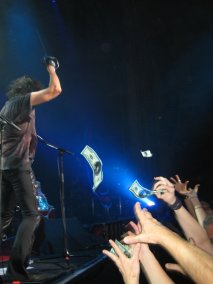 22. Billion Dollar Babies (Billion Dollar Babies, 1973). AC wielded a long sword that had pierced multiple fake $100 bills featuring AC’s image in lieu of Benjamin Franklin. AC swiftly swung the sword, causing the bills to fly off and into the crowd. At end of song AC decapitated the doll in the cart.
22. Billion Dollar Babies (Billion Dollar Babies, 1973). AC wielded a long sword that had pierced multiple fake $100 bills featuring AC’s image in lieu of Benjamin Franklin. AC swiftly swung the sword, causing the bills to fly off and into the crowd. At end of song AC decapitated the doll in the cart.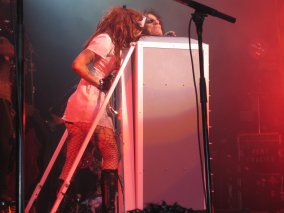 24. I Love the Dead (Billion Dollar Babies, 1973). The black hooded henchmen carted out a refrigerator size grey rectangular box with an iron maidenesque contraption featuring approximately 18 three inch long horizontal steel rods adjacent to the side of the box. A black hooded henchman forced AC into the box and shut the side door, only making AC’s head visible atop the box. The nurse went to the box side bearing the rods and violently pushed the rods into the box, impaling AC. The nurse carted the box containing AC off stage.
24. I Love the Dead (Billion Dollar Babies, 1973). The black hooded henchmen carted out a refrigerator size grey rectangular box with an iron maidenesque contraption featuring approximately 18 three inch long horizontal steel rods adjacent to the side of the box. A black hooded henchman forced AC into the box and shut the side door, only making AC’s head visible atop the box. The nurse went to the box side bearing the rods and violently pushed the rods into the box, impaling AC. The nurse carted the box containing AC off stage.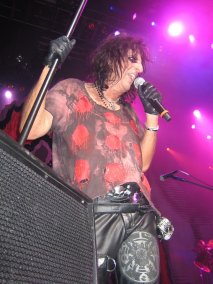 25. No More Mr. Nice Guy (Billion Dollar Babies, 1973) featured AC wearing a black t shirt with nine softball sized blood splatter marks, symbolizing where he was supposedly impaled by the rods. This song has a catchy chorus and has been covered by Megadeth for the soundtrack to the 1988 documentary, “The Decline of Western Civilization Part II: The Metal Years” directed by Penelope Spheeris. AC marched around with a black tuxedo cane that he eventually threw into the crowd. A scuffle broke out amidst the fans over rights to the cane warranting security intervention. [What the zealous fans who grasped the cane with dear life did not realize is they could have simply waited for AC by his tour bus and asked him to hand over the cane he used to aid his stride from WT to the bus (kidding Mr. Cooper).]
25. No More Mr. Nice Guy (Billion Dollar Babies, 1973) featured AC wearing a black t shirt with nine softball sized blood splatter marks, symbolizing where he was supposedly impaled by the rods. This song has a catchy chorus and has been covered by Megadeth for the soundtrack to the 1988 documentary, “The Decline of Western Civilization Part II: The Metal Years” directed by Penelope Spheeris. AC marched around with a black tuxedo cane that he eventually threw into the crowd. A scuffle broke out amidst the fans over rights to the cane warranting security intervention. [What the zealous fans who grasped the cane with dear life did not realize is they could have simply waited for AC by his tour bus and asked him to hand over the cane he used to aid his stride from WT to the bus (kidding Mr. Cooper).]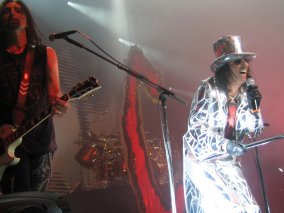 27. School’s Out (School’s Out, 1972) was performed a second time, this time in its entirety. AC wore an interesting outfit comprised of matching silver top hat, slacks, and jacket with tails (similar to that worn by symphony conductors) and featuring cracked mirror inlays that vibrantly reflected light. Stage hands tossed giant balloons on stage and into the crowd. When the balloons were popped by rabid fans and the headstock of KK, DJ, and CG’s instruments, confetti burst in the air.
27. School’s Out (School’s Out, 1972) was performed a second time, this time in its entirety. AC wore an interesting outfit comprised of matching silver top hat, slacks, and jacket with tails (similar to that worn by symphony conductors) and featuring cracked mirror inlays that vibrantly reflected light. Stage hands tossed giant balloons on stage and into the crowd. When the balloons were popped by rabid fans and the headstock of KK, DJ, and CG’s instruments, confetti burst in the air.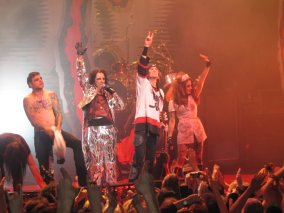 Two flashback memories are worthy of mention. The first is John Carpenter’s 1987 horror film, Prince of Darkness in which AC played the role of a homeless/zombie. After the show I waited for KK outside WT about 100 feet from the tour bus situated on the adjacent street. After speaking with CG, a non descript fellow wearing a plain cotton black jacket and pumpkin orange shirt emerged from WT’s side door and walked toward me (and the bus). When this fellow, accompanied by a burly WT security guard who I will call Neanderthal Ned (“NN”) came within 20 feet, I realized it was AC. AC had his head down, hands tightly tucked in pockets, and walked briskly as if he had not urinated since sound check, making it patently clear he did not want his “flow” (pardon the pun) interrupted. I could not help it. The adolescent in me took over and, as Alice walked by, I blurted out, “How are you doing Alice.” Alice looked up, muttered something incoherent with an odd expression on his face, and walked past me without a pause. AC looked and sounded like the homeless/zombie in Prince of Darkness. At that point, a handful of autograph hounds in the vicinity realized who was on the street and ran after AC, prompting NN to proclaim in a fairly loud voice, “We’re not stopping for nobody.” [Grammar (and higher education) are not NN’s strong suit, which I should have gathered by observing his attire, a black leather vest atop a white long sleeve thermal shirt and bright red t shirt, looking like an over the hill rugby player.] NN was right. AC walked straight past everyone and onto the bus.
Two flashback memories are worthy of mention. The first is John Carpenter’s 1987 horror film, Prince of Darkness in which AC played the role of a homeless/zombie. After the show I waited for KK outside WT about 100 feet from the tour bus situated on the adjacent street. After speaking with CG, a non descript fellow wearing a plain cotton black jacket and pumpkin orange shirt emerged from WT’s side door and walked toward me (and the bus). When this fellow, accompanied by a burly WT security guard who I will call Neanderthal Ned (“NN”) came within 20 feet, I realized it was AC. AC had his head down, hands tightly tucked in pockets, and walked briskly as if he had not urinated since sound check, making it patently clear he did not want his “flow” (pardon the pun) interrupted. I could not help it. The adolescent in me took over and, as Alice walked by, I blurted out, “How are you doing Alice.” Alice looked up, muttered something incoherent with an odd expression on his face, and walked past me without a pause. AC looked and sounded like the homeless/zombie in Prince of Darkness. At that point, a handful of autograph hounds in the vicinity realized who was on the street and ran after AC, prompting NN to proclaim in a fairly loud voice, “We’re not stopping for nobody.” [Grammar (and higher education) are not NN’s strong suit, which I should have gathered by observing his attire, a black leather vest atop a white long sleeve thermal shirt and bright red t shirt, looking like an over the hill rugby player.] NN was right. AC walked straight past everyone and onto the bus.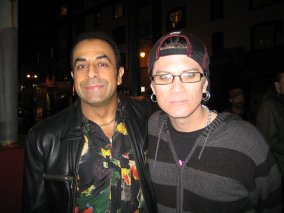 Second, NN’s poor grammar reminded me of Dr. Seuss’s classic children’s book, “Green Eggs and Ham” (1960). Earlier that evening I had an unpleasant interaction with NN. I simply asked him for the attendance. NN’s reaction made it seem as if I sought the security code to break into the Pentagon in Washington, D.C. (I estimate 1,700 people in attendance, which would have been higher had the ticket prices not been set at $42.50 face value.) I smiled at NN and walked away. Admittedly, when I later saw NN walk past me with AC, I was, for a nanosecond, tempted to commit a heinous act that would have surely resulted in loss of my license to practice law. I resisted the urge to run up to NN, jump up a few inches to reach his lofty height, crack his forehead open with a swift blow from my hard noggin, and subsequently snap his neck with a quick forceful twist of his head between my right thumb and middle finger, causing his limp Herculean frame to fall before my feet where I would use my combat boot to slosh it around like wet Thai noodle. However, the wisdom and anti violence stance of my devout Muslim father knocked me back to reality. I have instead decided to buy NN Dr. Seuss’s “Green Eggs and Ham” at the children’s section of the local bookstore. I will present the book to NN at the next WT show. Heck, I will even offer to put his large frame on my lap and read to him. “I do not eat green eggs and ham. I do not like them, Sam-I-am.”
Second, NN’s poor grammar reminded me of Dr. Seuss’s classic children’s book, “Green Eggs and Ham” (1960). Earlier that evening I had an unpleasant interaction with NN. I simply asked him for the attendance. NN’s reaction made it seem as if I sought the security code to break into the Pentagon in Washington, D.C. (I estimate 1,700 people in attendance, which would have been higher had the ticket prices not been set at $42.50 face value.) I smiled at NN and walked away. Admittedly, when I later saw NN walk past me with AC, I was, for a nanosecond, tempted to commit a heinous act that would have surely resulted in loss of my license to practice law. I resisted the urge to run up to NN, jump up a few inches to reach his lofty height, crack his forehead open with a swift blow from my hard noggin, and subsequently snap his neck with a quick forceful twist of his head between my right thumb and middle finger, causing his limp Herculean frame to fall before my feet where I would use my combat boot to slosh it around like wet Thai noodle. However, the wisdom and anti violence stance of my devout Muslim father knocked me back to reality. I have instead decided to buy NN Dr. Seuss’s “Green Eggs and Ham” at the children’s section of the local bookstore. I will present the book to NN at the next WT show. Heck, I will even offer to put his large frame on my lap and read to him. “I do not eat green eggs and ham. I do not like them, Sam-I-am.”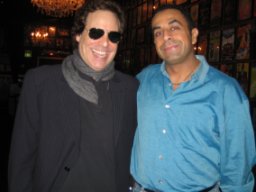 Prior to seeing Foreigner perform live, the band was, for the most part, foreign to me. As a teenager growing up in the 80s, my first allegiance was to Kiss. All is took was one listen to the song All Hell’s Breakin’ Loose and I was hooked. As the years progressed and the Bay Area thrash movement blossomed like a maggot-covered carcass in a fog laced graveyard, my tastes began to lean to harder edged music, Slayer, Exodus, Celtic Frost, Metallica, and Anthrax. For this reason, I initially wavered on attending the show. However, the band’s keyboardist, Michael Bluestein, graciously invited me to discuss the prospects of providing legal representation. I accepted his offer and attended donning a Motorhead t shirt. Interestingly, I was the only visible fan [yes, I admittedly said fan] donning a metal shirt and certainly the only one, aside from Jeff Pilson (bassist), head banging to Foreigner songs I heard yesteryear on television commercials selling “Songs from the 70s” records.
Prior to seeing Foreigner perform live, the band was, for the most part, foreign to me. As a teenager growing up in the 80s, my first allegiance was to Kiss. All is took was one listen to the song All Hell’s Breakin’ Loose and I was hooked. As the years progressed and the Bay Area thrash movement blossomed like a maggot-covered carcass in a fog laced graveyard, my tastes began to lean to harder edged music, Slayer, Exodus, Celtic Frost, Metallica, and Anthrax. For this reason, I initially wavered on attending the show. However, the band’s keyboardist, Michael Bluestein, graciously invited me to discuss the prospects of providing legal representation. I accepted his offer and attended donning a Motorhead t shirt. Interestingly, I was the only visible fan [yes, I admittedly said fan] donning a metal shirt and certainly the only one, aside from Jeff Pilson (bassist), head banging to Foreigner songs I heard yesteryear on television commercials selling “Songs from the 70s” records.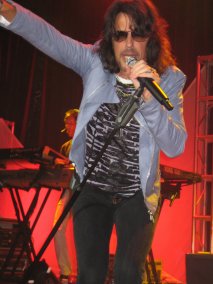 Foreigner started the concert, with no opening band, at 8:17 pm. The band played 15 songs discussed in greater detail below.
Foreigner started the concert, with no opening band, at 8:17 pm. The band played 15 songs discussed in greater detail below.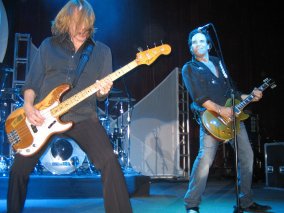 4. Good Morning Good Day is a poppy song with a catchy chorus. It featured Hansen playing the maracas.
4. Good Morning Good Day is a poppy song with a catchy chorus. It featured Hansen playing the maracas.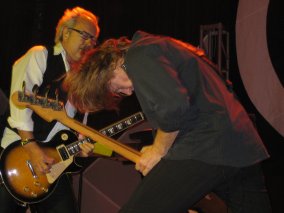 8. Say You Will featured Pilson, Brian Tichy (drummer), and Thom Gimbel (second guitarist and saxophonist) standing stage left in front of Tichy’s drum set. Pilson clapped, Tichy played a tambourine, and Gimbel played the maracas. On the other side, Jones played an acoustic guitar while Michael Bluestein (keyboardist) came toward the front of the stage to play Jones’s keyboards. [I wonder if Bluestein gets nervous about tarnishing the ivory keys of overlord Jones’s keyboard?] Pilson, formerly of Dokken, has handled bass duties since 2004. He appeared in silk/cotton black slacks and long sleeve black shirt. At the end of the song Hansen revisited his fascination and longing for the forbidden weed by stating, “The ganja is getting to me. I am getting hungry.”
8. Say You Will featured Pilson, Brian Tichy (drummer), and Thom Gimbel (second guitarist and saxophonist) standing stage left in front of Tichy’s drum set. Pilson clapped, Tichy played a tambourine, and Gimbel played the maracas. On the other side, Jones played an acoustic guitar while Michael Bluestein (keyboardist) came toward the front of the stage to play Jones’s keyboards. [I wonder if Bluestein gets nervous about tarnishing the ivory keys of overlord Jones’s keyboard?] Pilson, formerly of Dokken, has handled bass duties since 2004. He appeared in silk/cotton black slacks and long sleeve black shirt. At the end of the song Hansen revisited his fascination and longing for the forbidden weed by stating, “The ganja is getting to me. I am getting hungry.”
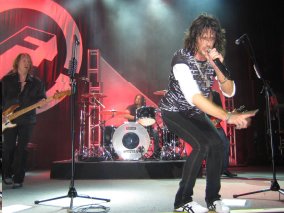 10. Feels Like the First Time features a catchy chorus and guitar solo by Gimbel. Gimbel, who has handled guitar and saxophone duties in 1993 and since 1995, wore blue jeans and a long sleeve black shirt. Although Gimbel has the longest tenure in Foreigner aside from Jones, he, at times, looked a bit awkward onstage, overdoing the macho poses and scrunching his lips sideways as if recently injected with a heavy dose of Novocain. [Gimbel bears a resemblance to childhood actor Barry Williams who played Greg Brady in the popular 60s American television show, “The Brady Bunch.” I know, enough already with the resemblances. But I could not help it. About the half the band looked eerily like other celebrities.]
10. Feels Like the First Time features a catchy chorus and guitar solo by Gimbel. Gimbel, who has handled guitar and saxophone duties in 1993 and since 1995, wore blue jeans and a long sleeve black shirt. Although Gimbel has the longest tenure in Foreigner aside from Jones, he, at times, looked a bit awkward onstage, overdoing the macho poses and scrunching his lips sideways as if recently injected with a heavy dose of Novocain. [Gimbel bears a resemblance to childhood actor Barry Williams who played Greg Brady in the popular 60s American television show, “The Brady Bunch.” I know, enough already with the resemblances. But I could not help it. About the half the band looked eerily like other celebrities.]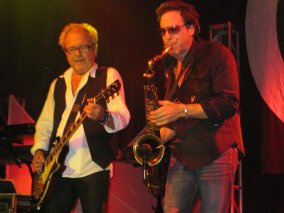 13. Long, Long Way from Home was the first encore song, an up tempo track after which Hansen told the crowd, “I need a medical marijuana prescription.” [I somehow get the feeling Hansen is a huge fan of the Cheech and Chong flicks because marijuana plays a central theme in these cult classics.]
13. Long, Long Way from Home was the first encore song, an up tempo track after which Hansen told the crowd, “I need a medical marijuana prescription.” [I somehow get the feeling Hansen is a huge fan of the Cheech and Chong flicks because marijuana plays a central theme in these cult classics.]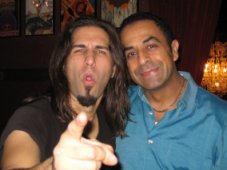 Two flashback memories are worthy of mention. First, I recall standing outside The Stone in San Francisco on November 3, 1986, shortly after Slayer annihilated all living things at the tiny club on the Reign in Blood tour. A zealous fan, fresh from the carnage in the moshing pit, approached a younger, meek fan likely waiting for his parents to pick him up in front of the venue, and called him “a poseur,” presumably for not being rough and tumble enough. Shortly into Foreigner’s set, I knew my review would be very favorable. Does this qualify me as a poseur, much like that fan outside the Slayer concert some 23 years ago? Will I have to hire a bodyguard to protect my beleaguered frame once word spreads among the metal contingent of my positive review?
Two flashback memories are worthy of mention. First, I recall standing outside The Stone in San Francisco on November 3, 1986, shortly after Slayer annihilated all living things at the tiny club on the Reign in Blood tour. A zealous fan, fresh from the carnage in the moshing pit, approached a younger, meek fan likely waiting for his parents to pick him up in front of the venue, and called him “a poseur,” presumably for not being rough and tumble enough. Shortly into Foreigner’s set, I knew my review would be very favorable. Does this qualify me as a poseur, much like that fan outside the Slayer concert some 23 years ago? Will I have to hire a bodyguard to protect my beleaguered frame once word spreads among the metal contingent of my positive review? A select few rock/metal figures have withstood the test of time. Regardless of whether the focus was on bell bottoms in the 70’s, spandex in the 80’s, or god knows what in the 90’s (possibly flannel), these figures have transcended trends in fashion and music, garnering the respect of rock/metal fans as a whole. Tony Iommi, Jimmy Page, Ozzy Osbourne, Ronnie James Dio, and Lemmy Kilmister (“LK”) fall in this category.
A select few rock/metal figures have withstood the test of time. Regardless of whether the focus was on bell bottoms in the 70’s, spandex in the 80’s, or god knows what in the 90’s (possibly flannel), these figures have transcended trends in fashion and music, garnering the respect of rock/metal fans as a whole. Tony Iommi, Jimmy Page, Ozzy Osbourne, Ronnie James Dio, and Lemmy Kilmister (“LK”) fall in this category.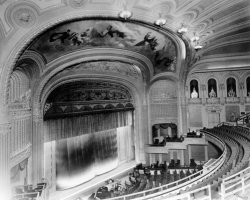 WT, captured on Slayer’s 2001 DVD entitled, War at the Warfield, is a 2,500 seat capacity theater built in 1927 and renovated in September 2008. WT’s layout presents a dichotomy. On the one hand, the theater’s beauty is exemplified by intricate frescos of matadors and angels painted on the ceiling atop the stage. Box seats that have long been put out of use adorn each side of the stage and the walls of the seated balcony are a vibrant plum red and gold combination. On the other hand, the standing room only floor has a stark industrial feel with black walls and floor. The walls are carpet padded, serving a safety function for your injury prone writer who trounced around like a whirling dervish at Slayer and Megadeth shows.
WT, captured on Slayer’s 2001 DVD entitled, War at the Warfield, is a 2,500 seat capacity theater built in 1927 and renovated in September 2008. WT’s layout presents a dichotomy. On the one hand, the theater’s beauty is exemplified by intricate frescos of matadors and angels painted on the ceiling atop the stage. Box seats that have long been put out of use adorn each side of the stage and the walls of the seated balcony are a vibrant plum red and gold combination. On the other hand, the standing room only floor has a stark industrial feel with black walls and floor. The walls are carpet padded, serving a safety function for your injury prone writer who trounced around like a whirling dervish at Slayer and Megadeth shows.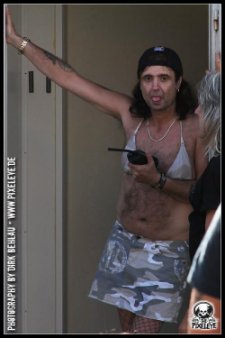 Shortly before Motorhead took the stage I looked behind me and it was clear this was a sold out show, like Motorhead’s 2005 gig. The crowd did not grow restless as the band had the courtesy of avoiding the Axl Rose syndrome, punctually taking the stage at 10:15 after a 30 minute set change.
Shortly before Motorhead took the stage I looked behind me and it was clear this was a sold out show, like Motorhead’s 2005 gig. The crowd did not grow restless as the band had the courtesy of avoiding the Axl Rose syndrome, punctually taking the stage at 10:15 after a 30 minute set change.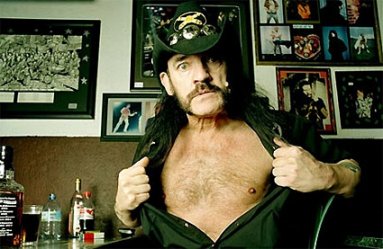
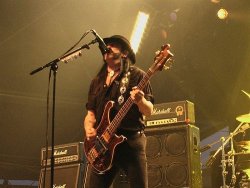 1.
1. 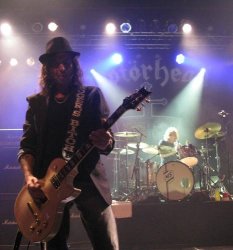 11.
11. 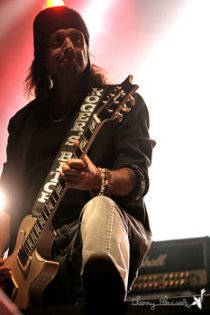 14.
14. 